 3 September 2012 – The ferry terminal in Cherbourg was comfortable and I did not have to wait long before catching my ferry to Poole in the UK.
3 September 2012 – The ferry terminal in Cherbourg was comfortable and I did not have to wait long before catching my ferry to Poole in the UK. 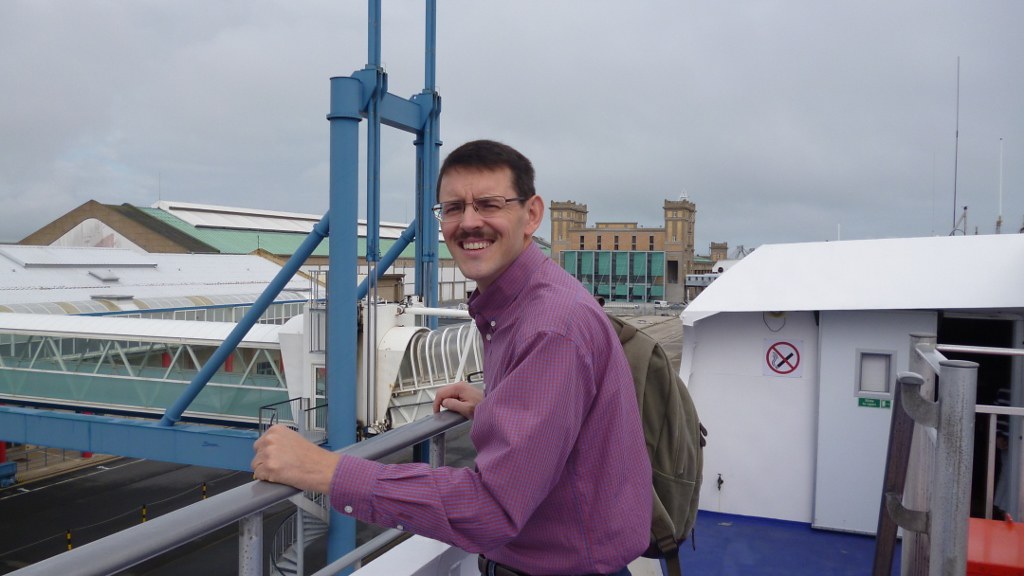 Aboard the ferry to take me from Cherbourg to Poole.
Aboard the ferry to take me from Cherbourg to Poole. 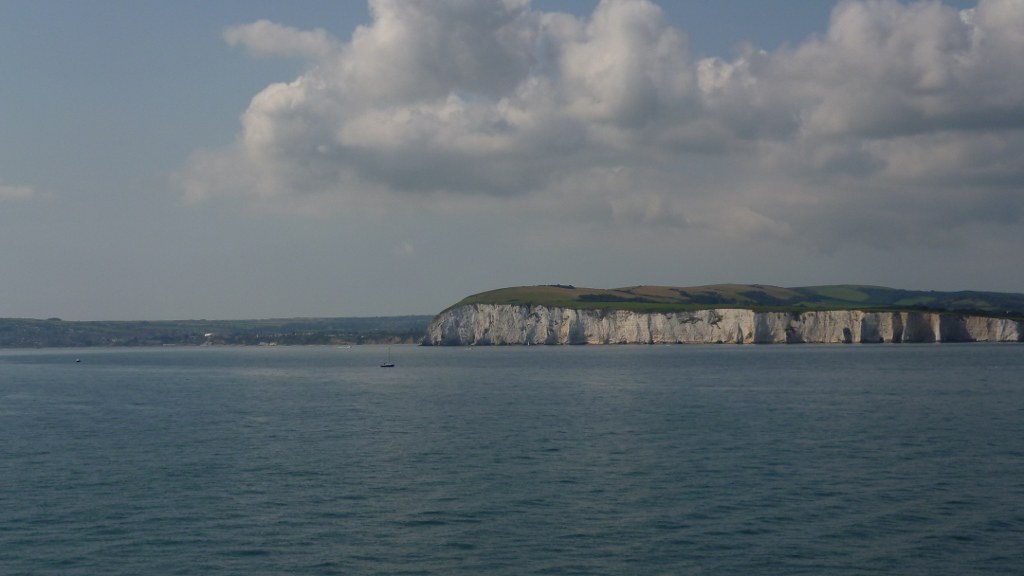 The white cliffs of England as seen from the ferry as it pulled into Poole Harbor. I took a train from Poole in order to get to Southampton where my cruise aboard the MSC Opera would begin.
The white cliffs of England as seen from the ferry as it pulled into Poole Harbor. I took a train from Poole in order to get to Southampton where my cruise aboard the MSC Opera would begin. 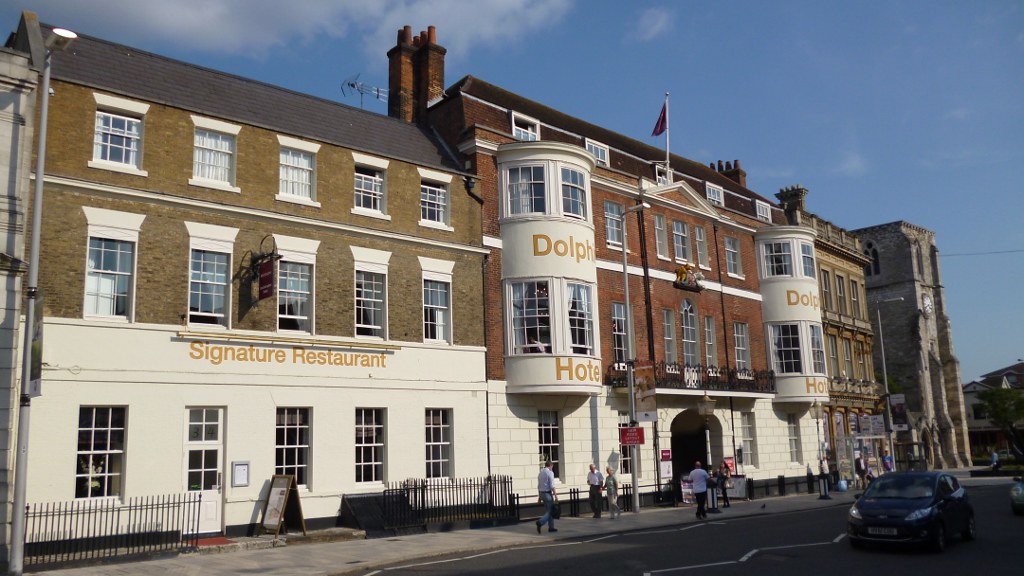 I stayed one night at the famous Dolphin Hotel where writer Jane Austin celebrated her 18th birthday on 16 December 1793 with her brother Frank. At that time, Jane was living with her cousins, the Butler-Harrisons on St. Mary’s Street. According to Jane’s letters, she attended two other dances at the Dolphin ballroom, a beautiful bow-windowed room on the first floor.
I stayed one night at the famous Dolphin Hotel where writer Jane Austin celebrated her 18th birthday on 16 December 1793 with her brother Frank. At that time, Jane was living with her cousins, the Butler-Harrisons on St. Mary’s Street. According to Jane’s letters, she attended two other dances at the Dolphin ballroom, a beautiful bow-windowed room on the first floor. 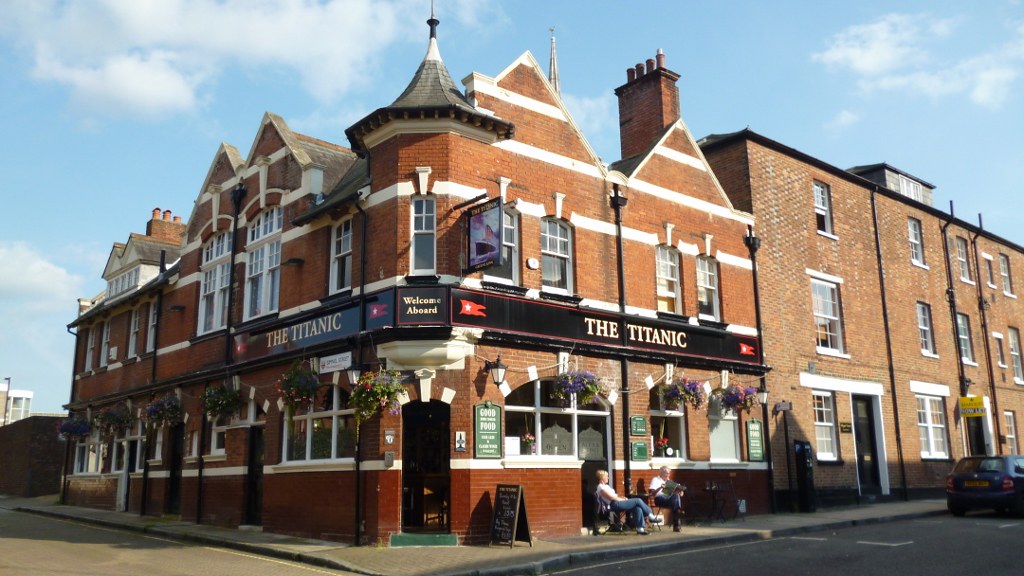 There is a famous pub nearby called The Titanic because legend has it that six crew members of the Titanic, including three brothers, were drinking in the pub before setting sail and after a few pints of ale, lost track of time and missed the ill-fated passage. As a popular hostelry of the time, it was a favorite amongst crew and passengers alike, but the tale is still cited today as a sign of its lucky influence and the numerous pictures and memorabilia of the times still adorn the walls today.
There is a famous pub nearby called The Titanic because legend has it that six crew members of the Titanic, including three brothers, were drinking in the pub before setting sail and after a few pints of ale, lost track of time and missed the ill-fated passage. As a popular hostelry of the time, it was a favorite amongst crew and passengers alike, but the tale is still cited today as a sign of its lucky influence and the numerous pictures and memorabilia of the times still adorn the walls today. 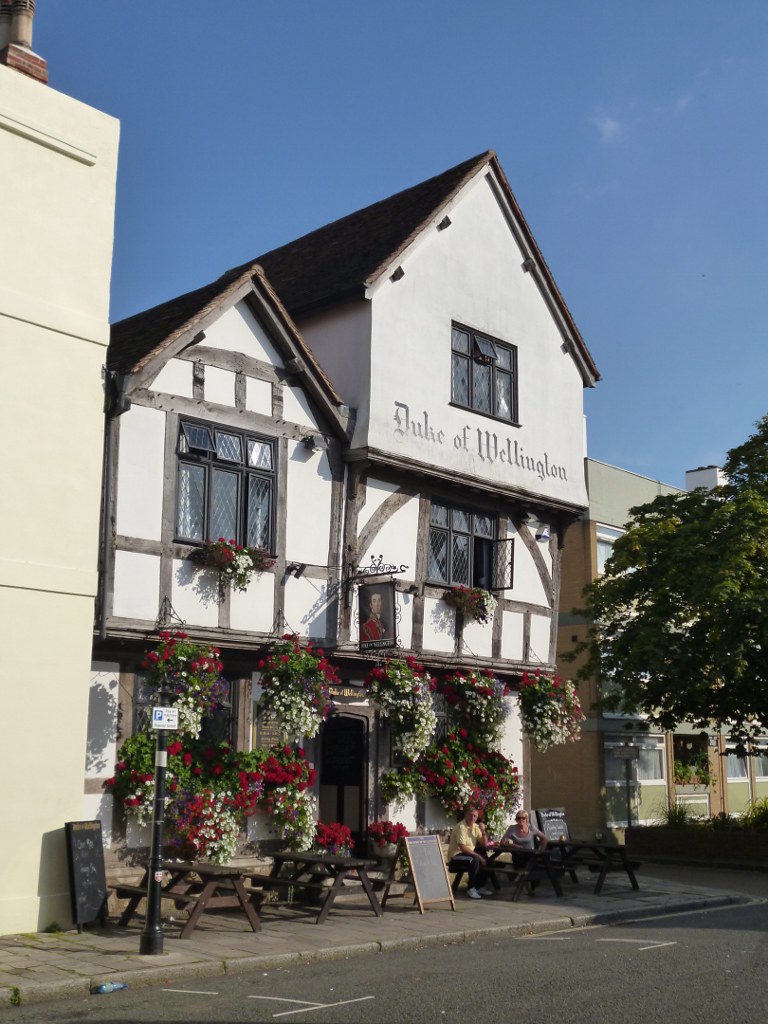 The Duke of Wellington Pub. The 12th century stone house on this site was from 1220 owned by Benedict Ace, one of the earliest named mayors of Southampton, from 1237-1245. The house was damaged in the French raid of 1338, but around 1490 was incorporated into the present building by a brewer, Rowland Johnson, and named it the Bere House. It has remained an inn ever since, but its name was changed to the Duke of Wellington after the battle of Waterloo. It was damaged by enemy action during the 1939-45 war and was restored during 1962-63.
The Duke of Wellington Pub. The 12th century stone house on this site was from 1220 owned by Benedict Ace, one of the earliest named mayors of Southampton, from 1237-1245. The house was damaged in the French raid of 1338, but around 1490 was incorporated into the present building by a brewer, Rowland Johnson, and named it the Bere House. It has remained an inn ever since, but its name was changed to the Duke of Wellington after the battle of Waterloo. It was damaged by enemy action during the 1939-45 war and was restored during 1962-63. 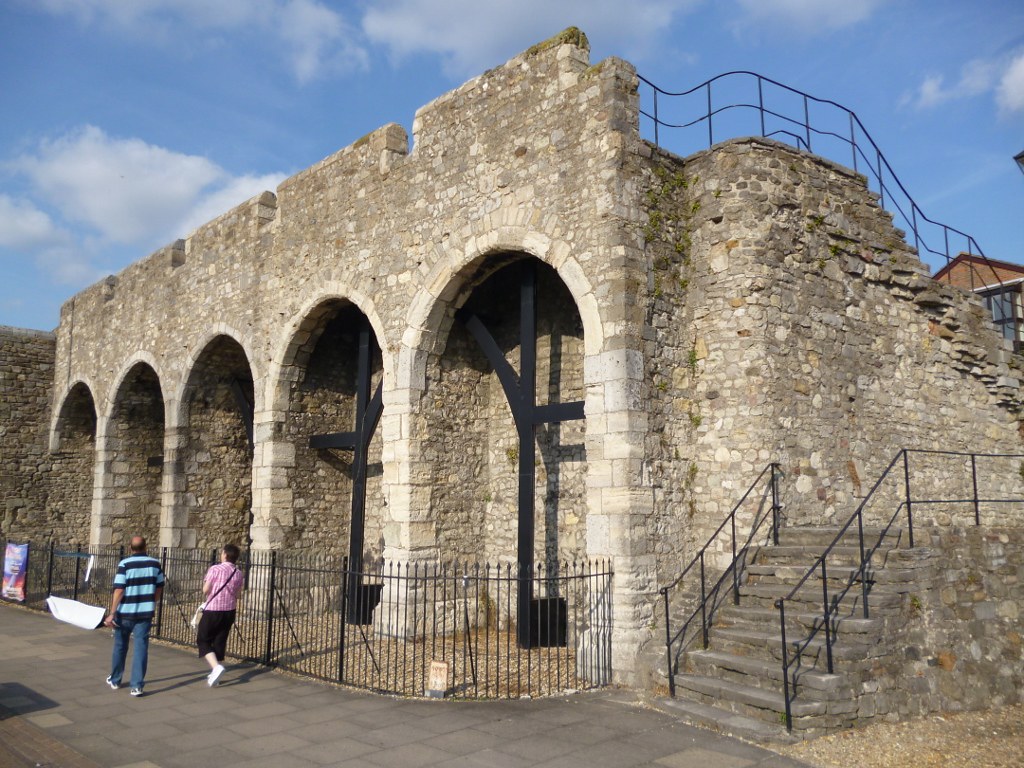 The city is home to the longest surviving stretch of medieval walls in England.
The city is home to the longest surviving stretch of medieval walls in England. 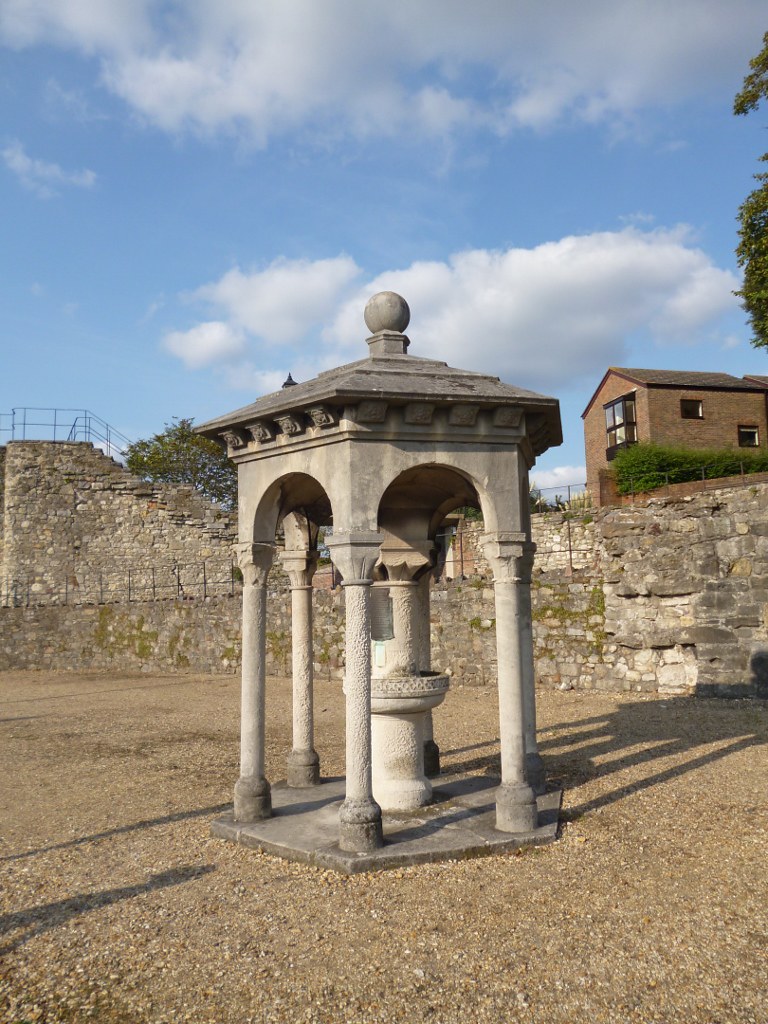 “In memory of the heroic death of Mary Anne Rogers, stewardess of the Stella who, on the night of the 30th of March 1899, amid the confusion and terror of shipwreck, aided all the women under her charge to quit the vessel in safety, giving her own life belt to one who was unprotected. Urged by the sailors to make her escape, she refused lest she might endanger the heavily laden boat. Cheering the departing crew with the friendly cry of “Goodbye, Goodbye” she was seen a few moments later as the Stella went down lifting her arms upwards with the prayer, “Lord have me” then sank in the waters with the sinking ship.”
“In memory of the heroic death of Mary Anne Rogers, stewardess of the Stella who, on the night of the 30th of March 1899, amid the confusion and terror of shipwreck, aided all the women under her charge to quit the vessel in safety, giving her own life belt to one who was unprotected. Urged by the sailors to make her escape, she refused lest she might endanger the heavily laden boat. Cheering the departing crew with the friendly cry of “Goodbye, Goodbye” she was seen a few moments later as the Stella went down lifting her arms upwards with the prayer, “Lord have me” then sank in the waters with the sinking ship.” 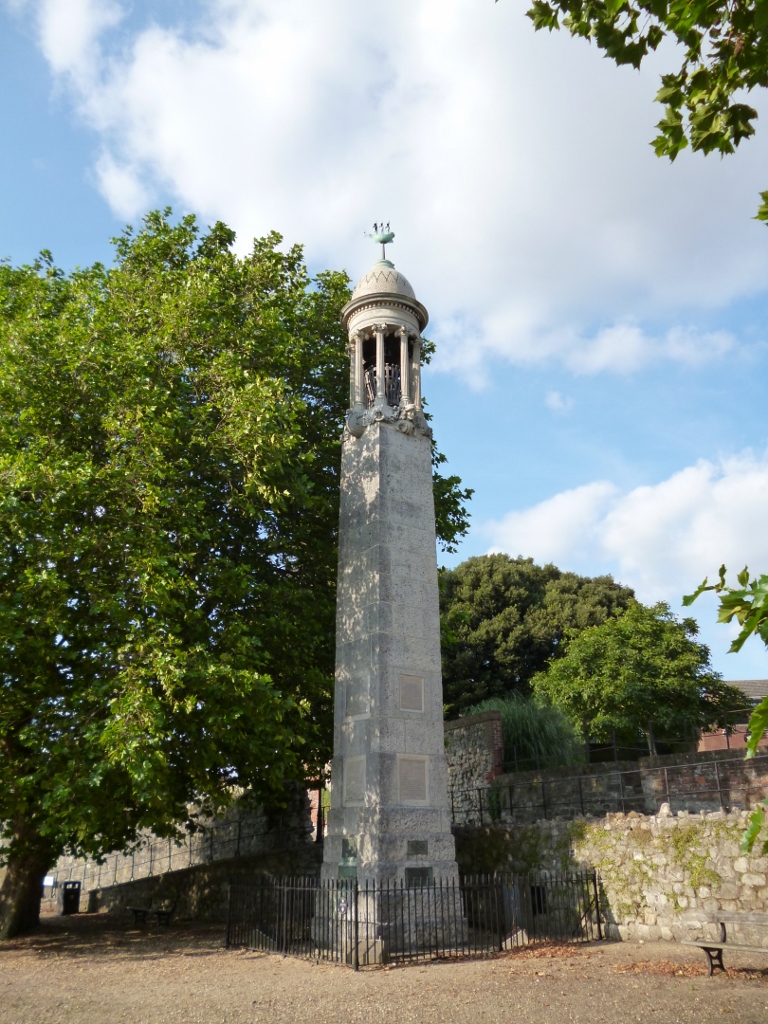 “The Pilgrim Fathers Memorial. The separatist congregation from Babworth, Nottinghamshire (1586-1604), which moved to Scrooby in 1606, to Amsterdam, Netherlands, in 1608, and to Leyden in 1609, sailed from Delft Haven in the Speedwell, on August 1, 1620, to join the Mayflower, with its London colonists. Here, both ships sailed on August 15, 1620 for the New World. After turning back to Dartmouth, and a second time to Plymouth for repairs, the Speedwell was abandoned, and on September 16, the Mayflower alone sailed to Plymouth, New England, with 102 passengers.”
“The Pilgrim Fathers Memorial. The separatist congregation from Babworth, Nottinghamshire (1586-1604), which moved to Scrooby in 1606, to Amsterdam, Netherlands, in 1608, and to Leyden in 1609, sailed from Delft Haven in the Speedwell, on August 1, 1620, to join the Mayflower, with its London colonists. Here, both ships sailed on August 15, 1620 for the New World. After turning back to Dartmouth, and a second time to Plymouth for repairs, the Speedwell was abandoned, and on September 16, the Mayflower alone sailed to Plymouth, New England, with 102 passengers.” 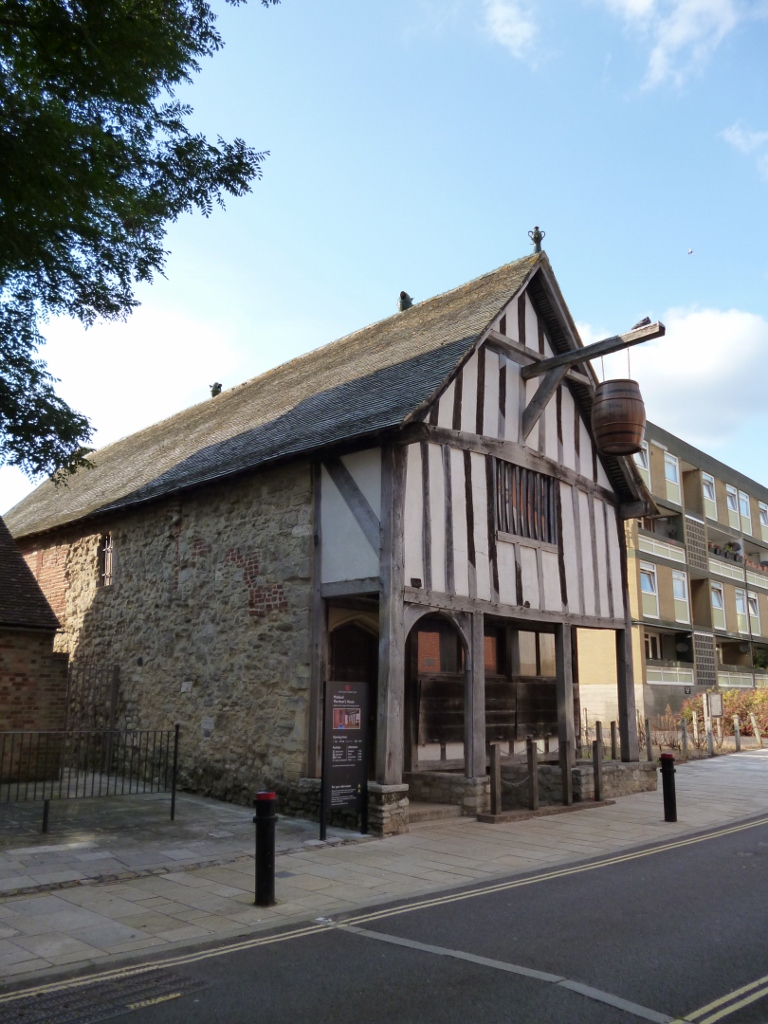 The Medieval Merchant’s House built in 1290.
The Medieval Merchant’s House built in 1290. 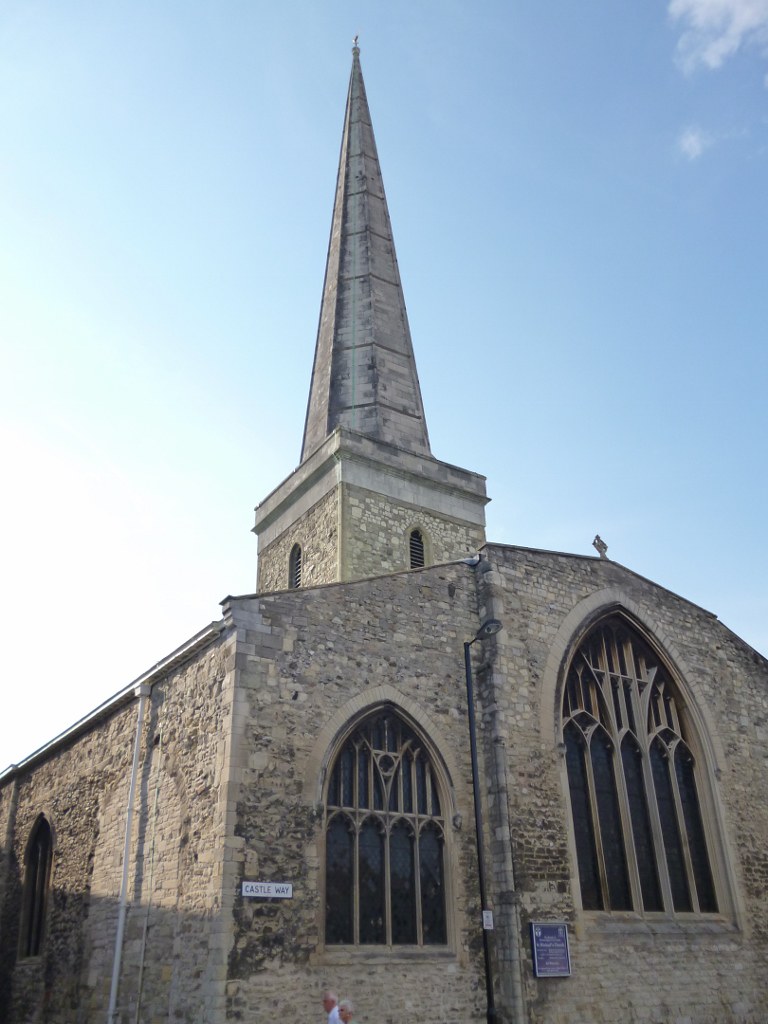 St. Michael's Church is the oldest building still in use in the city of Southampton, having been founded in 1070, and is the only church still active of the five originally in the medieval walled town.
St. Michael's Church is the oldest building still in use in the city of Southampton, having been founded in 1070, and is the only church still active of the five originally in the medieval walled town.  The Juniper Berry Pub. This was Jane Austin’s home from 1807 to 1809. It was rented from the Marquis of Lansdowne, who lived opposite in his mock-Gothic castle. The Austen’s garden stretched back to the town walls, affording extensive views of the New Forest. At that time, the River Test, at high tide, reached the base of the walls.
The Juniper Berry Pub. This was Jane Austin’s home from 1807 to 1809. It was rented from the Marquis of Lansdowne, who lived opposite in his mock-Gothic castle. The Austen’s garden stretched back to the town walls, affording extensive views of the New Forest. At that time, the River Test, at high tide, reached the base of the walls. 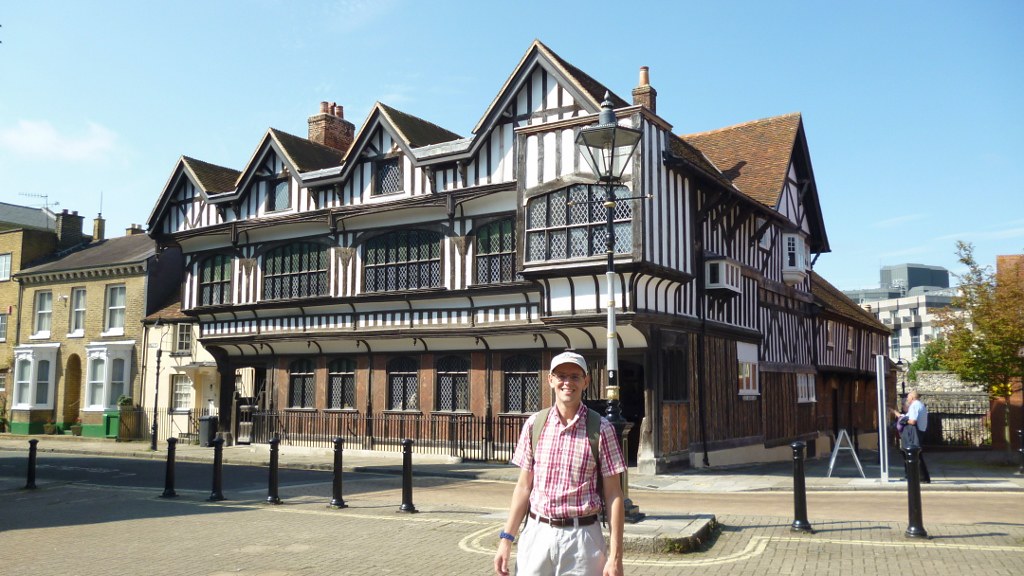
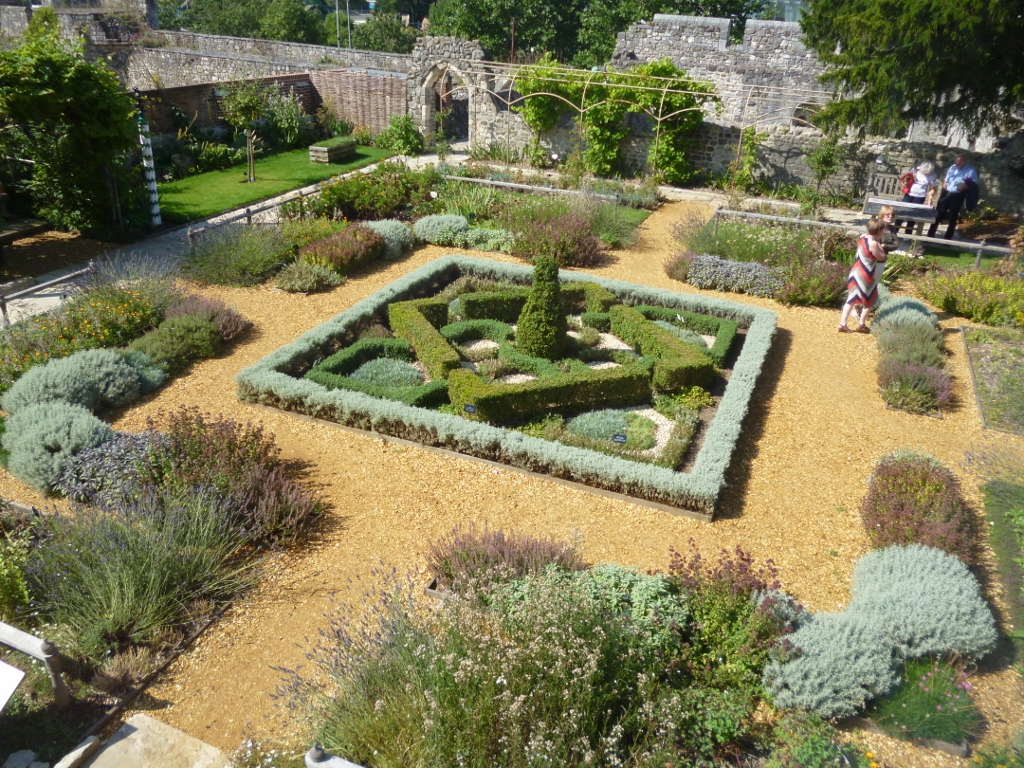 The Tudor House and Garden, located in the heart of the Old Town is Southampton’s most important historic building. The timber-framed building facing St. Michael’s Square was built in the late 15th Century, with King John’s Palace, an adjacent Norman house accessible from Tudor House Garden, dating back a further 300 years.
The Tudor House and Garden, located in the heart of the Old Town is Southampton’s most important historic building. The timber-framed building facing St. Michael’s Square was built in the late 15th Century, with King John’s Palace, an adjacent Norman house accessible from Tudor House Garden, dating back a further 300 years. 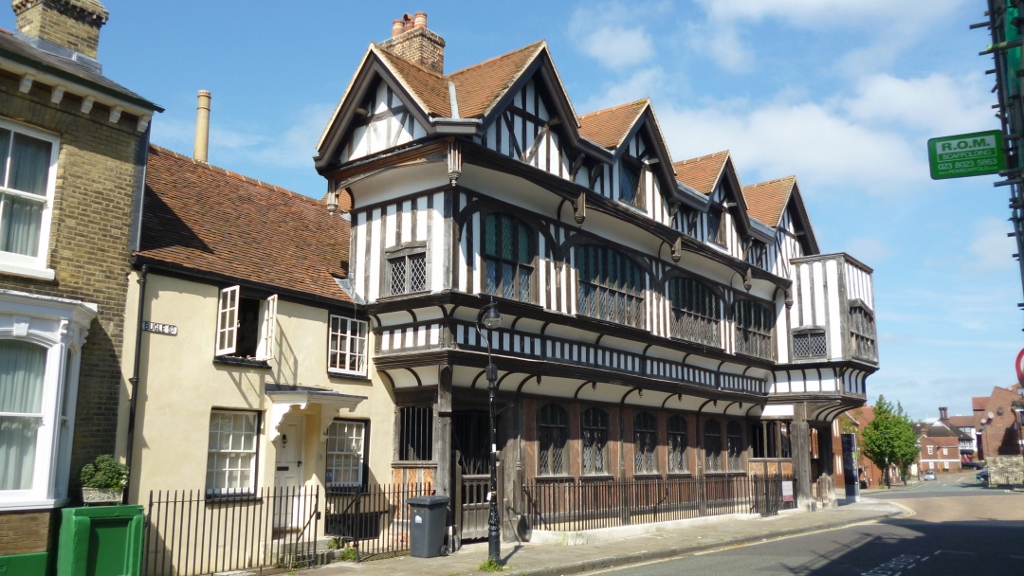
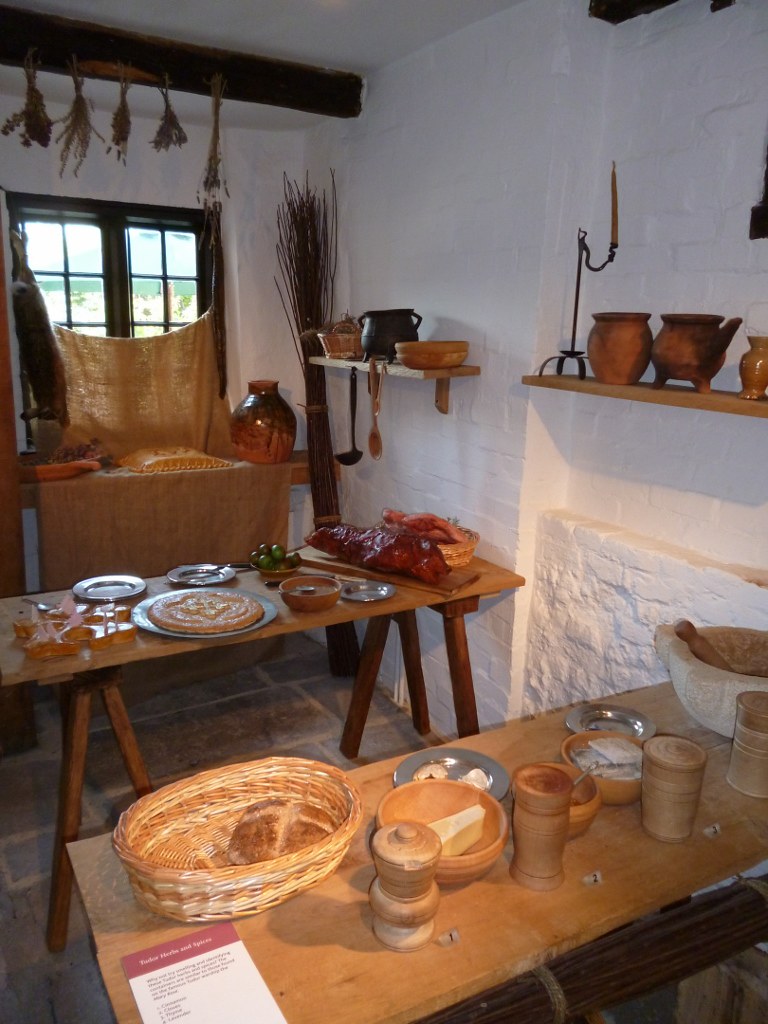
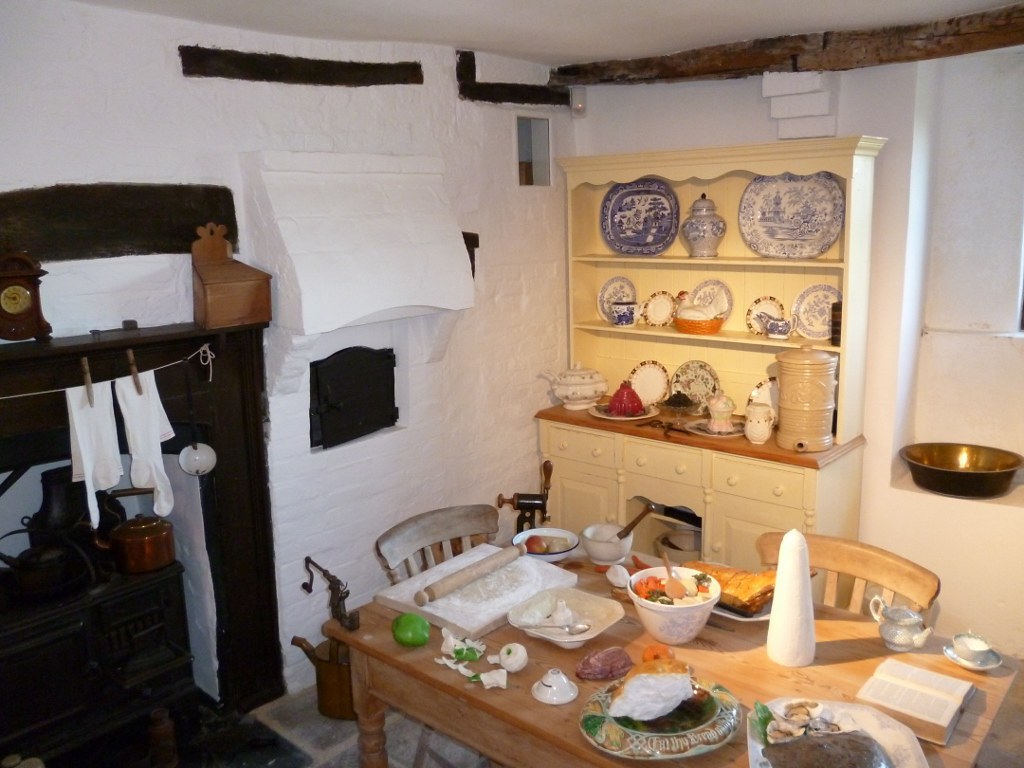 The Tudor House has several rooms including a kitchen and bakery which have been remodelled to show what life was like in the house during the Victorian age.
The Tudor House has several rooms including a kitchen and bakery which have been remodelled to show what life was like in the house during the Victorian age. 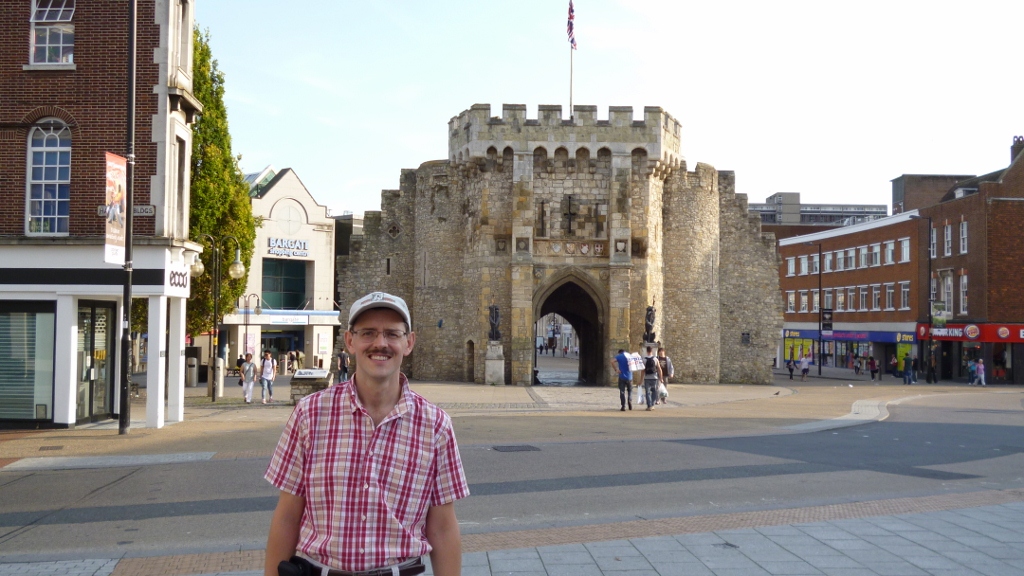
 The Bargate was constructed in 1180 as part of the fortified walled city. It served as the main point of entry and exit to and from the north. Additional archways were added to the Bargate in 1764 and 1774.
The Bargate was constructed in 1180 as part of the fortified walled city. It served as the main point of entry and exit to and from the north. Additional archways were added to the Bargate in 1764 and 1774. 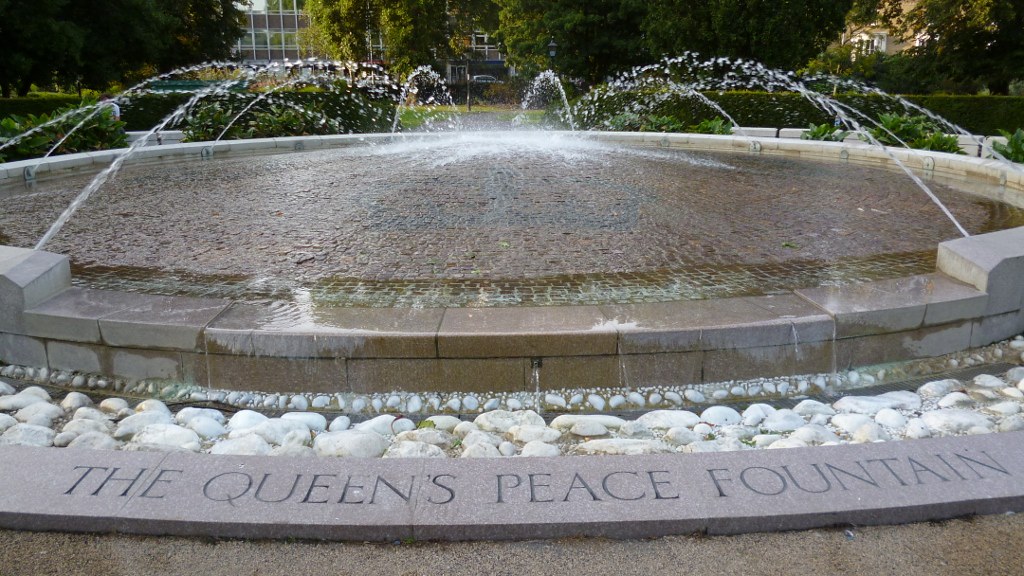 The Queen’s Peace Fountain in Andrews Park.
The Queen’s Peace Fountain in Andrews Park. 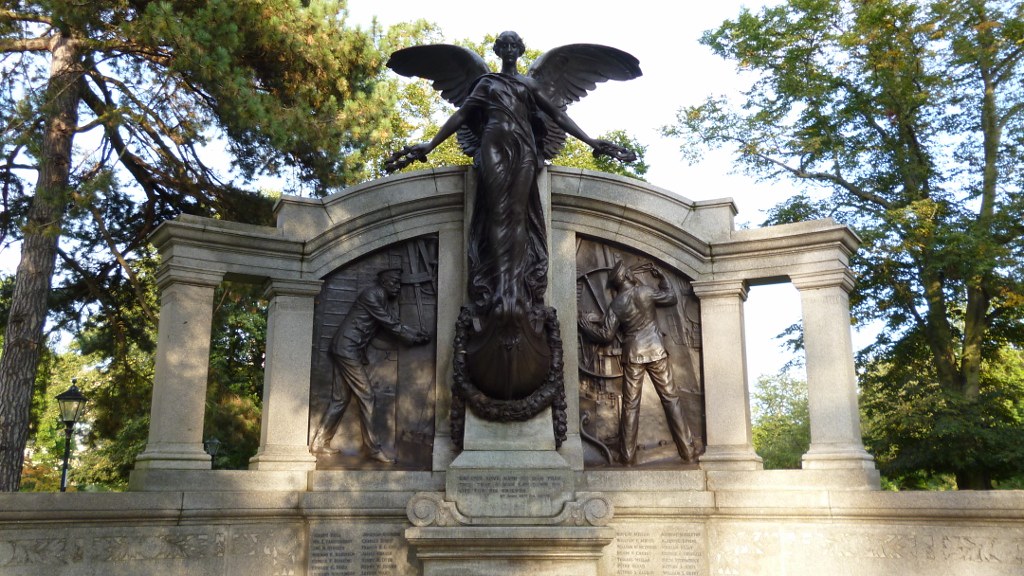 The Titanic Engineers’ Memorial in Andrews Park.
The Titanic Engineers’ Memorial in Andrews Park. 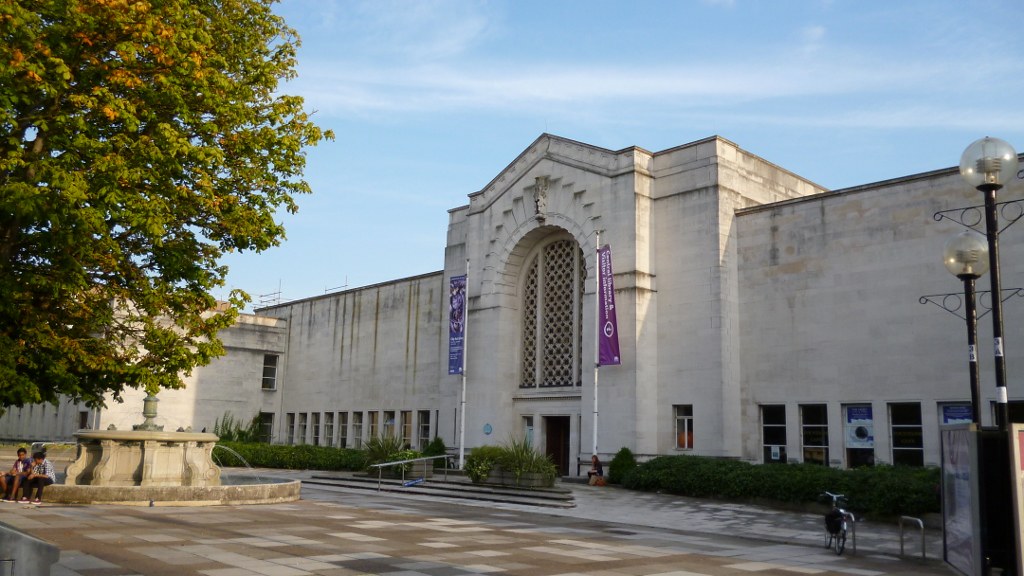
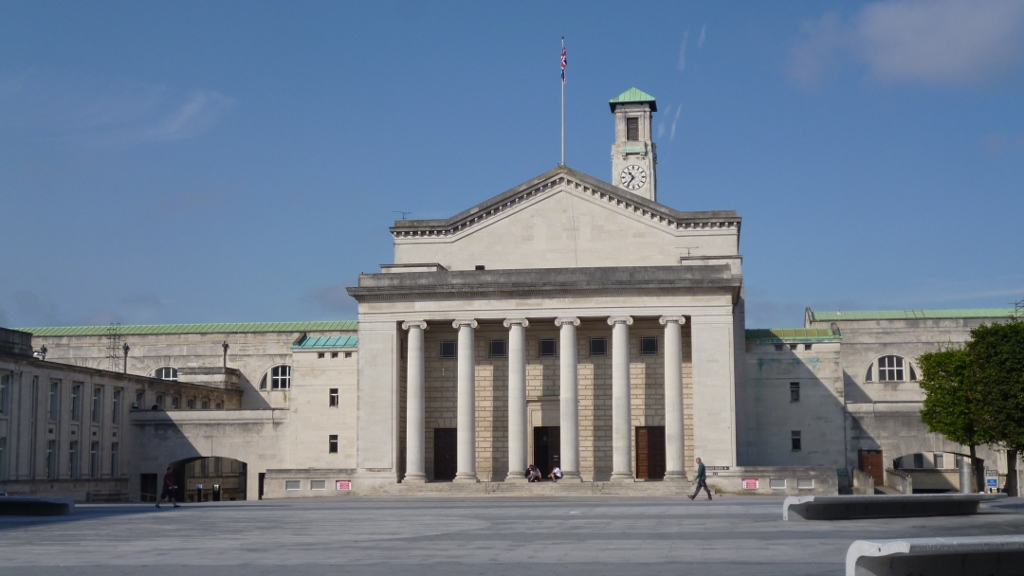
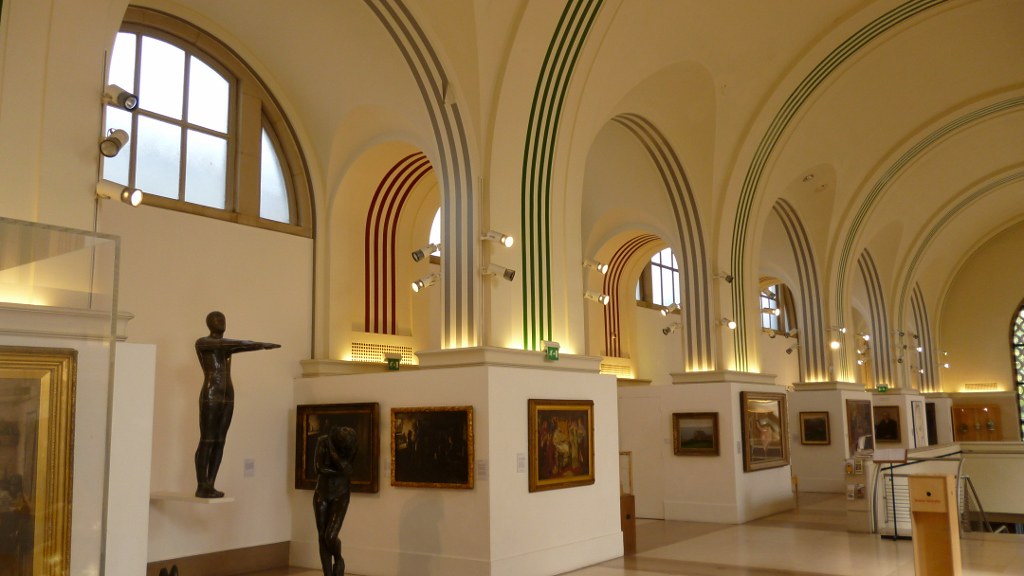 The Southampton Civic Center which houses the City Art Gallery and Central Library was built during the early 1930s.
The Southampton Civic Center which houses the City Art Gallery and Central Library was built during the early 1930s. 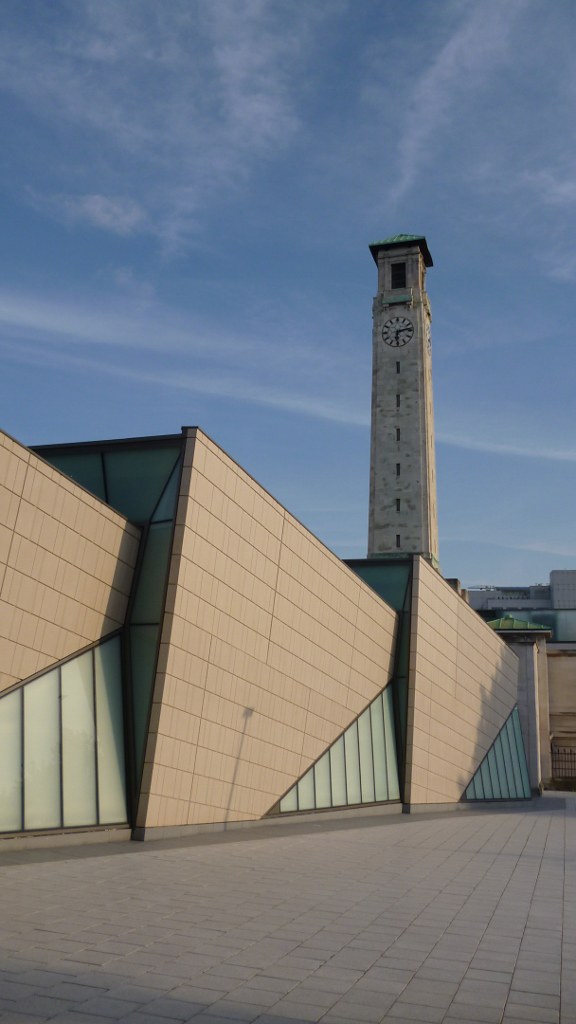 The west block includes the famous clock tower, known colloquially as Kimber's Chimney, after the former mayor. The clock tower was not part of the original design, but was added later. Before its construction, a balloon was tied on the site at the proposed height to make sure it was visible from various points in the city. Every four hours the first verse of the hymn O God, Our Help in Ages Past is played.
The west block includes the famous clock tower, known colloquially as Kimber's Chimney, after the former mayor. The clock tower was not part of the original design, but was added later. Before its construction, a balloon was tied on the site at the proposed height to make sure it was visible from various points in the city. Every four hours the first verse of the hymn O God, Our Help in Ages Past is played. 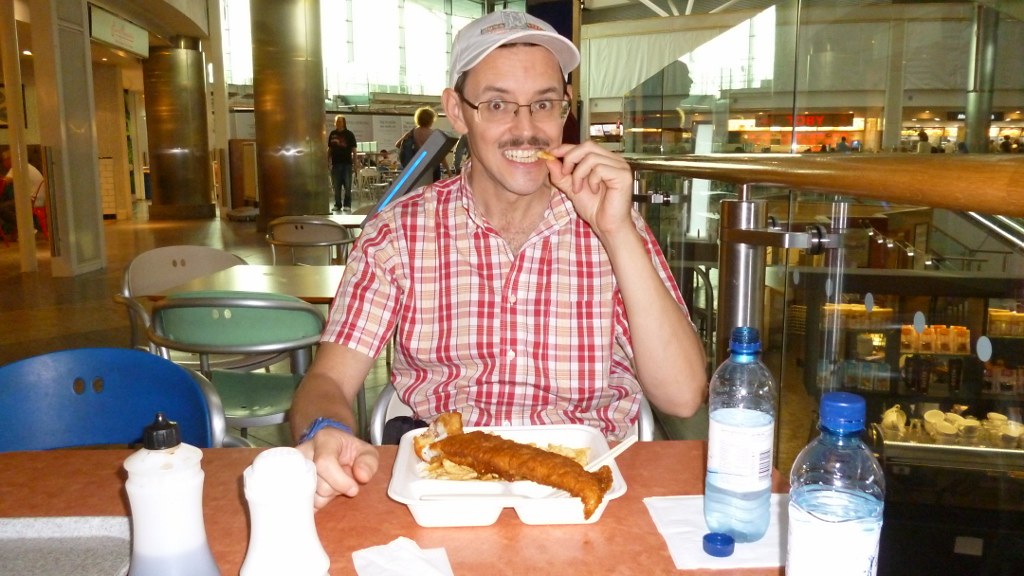 Before I shaved off my moustache—eating fish and chips for dinner.
Before I shaved off my moustache—eating fish and chips for dinner.  The next morning eating a full English breakfast in the Dolphin Hotel after I shaved off my moustache.
The next morning eating a full English breakfast in the Dolphin Hotel after I shaved off my moustache. 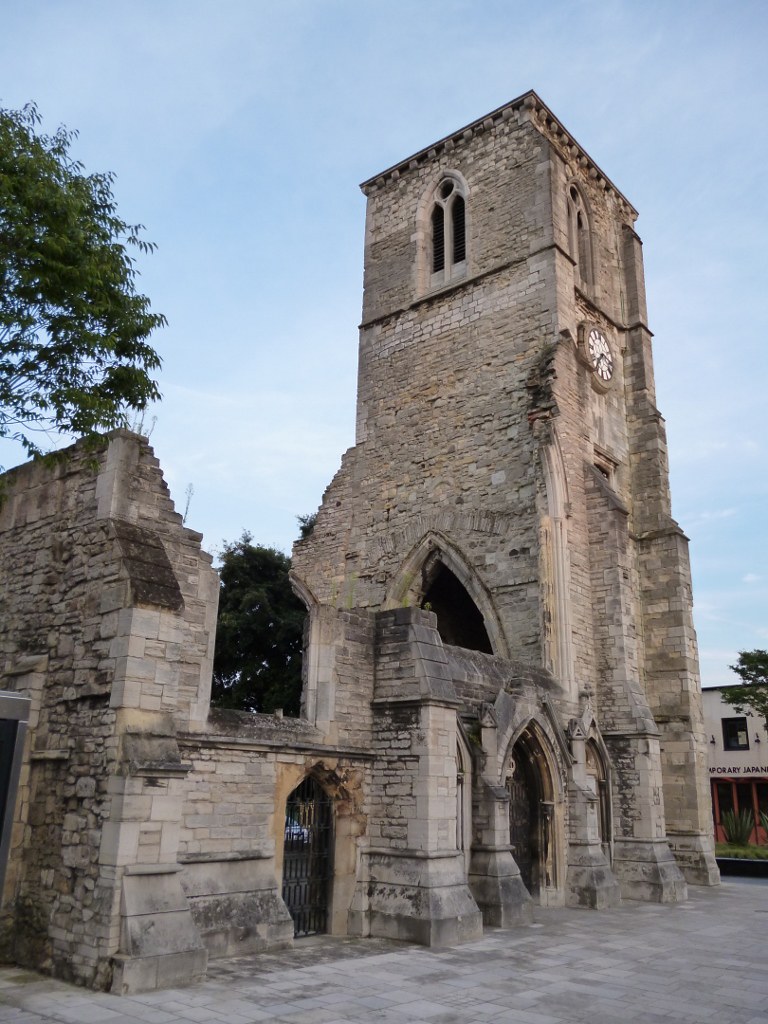 Holyrood Church was one of the original five churches serving the old walled town of Southampton. Built in 1320, the church was destroyed by enemy bombing during the blitz in November 1940. In 1957 the shell of the church was dedicated as a memorial to the sailors of the Merchant Navy.
Holyrood Church was one of the original five churches serving the old walled town of Southampton. Built in 1320, the church was destroyed by enemy bombing during the blitz in November 1940. In 1957 the shell of the church was dedicated as a memorial to the sailors of the Merchant Navy. 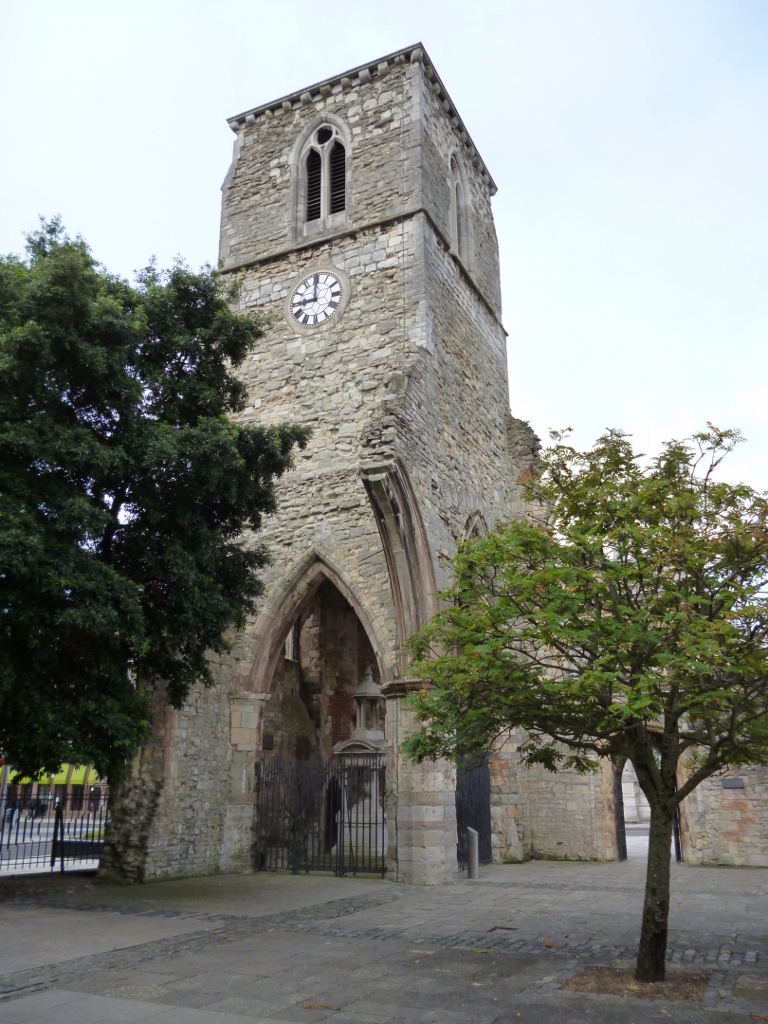 Inside the church, under the tower is a memorial fountain, erected in 1912–13 for those who lost their lives in the sinking of the RMS Titanic, which was removed from its original site in Cemetery Road on Southampton Common.
Inside the church, under the tower is a memorial fountain, erected in 1912–13 for those who lost their lives in the sinking of the RMS Titanic, which was removed from its original site in Cemetery Road on Southampton Common. 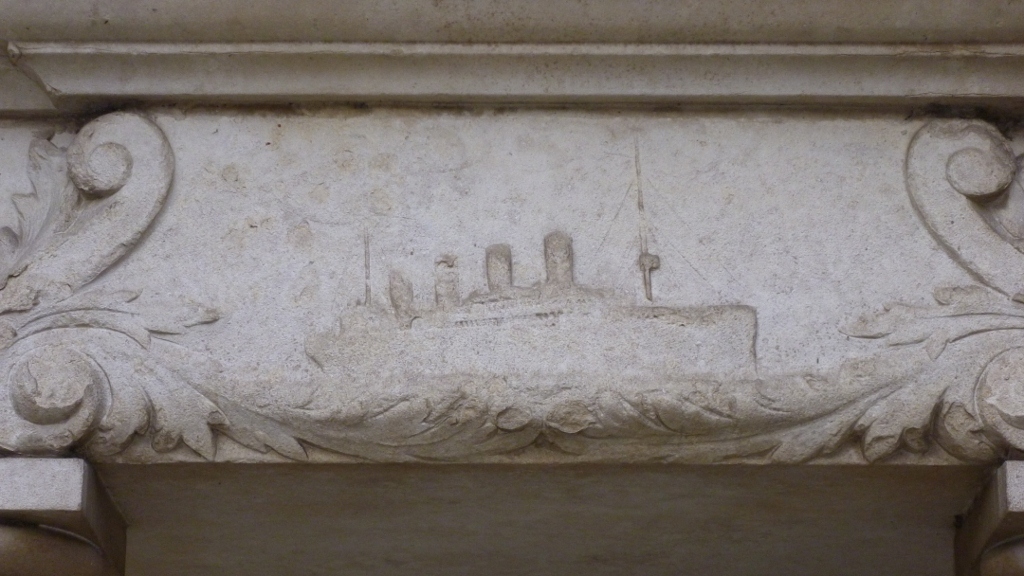 The fountain is supported on four stone columns, with a curved pediment on each side with carvings depicting the Titanic, surmounted by a four-columned cupola.
The fountain is supported on four stone columns, with a curved pediment on each side with carvings depicting the Titanic, surmounted by a four-columned cupola. 
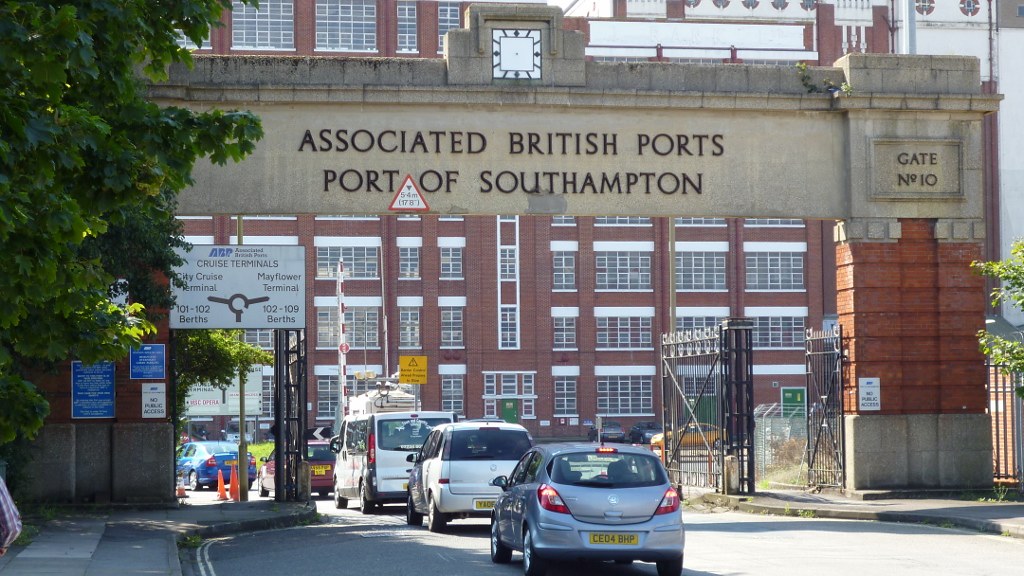 4 September 2012—Check-in at the counter in Southampton was very fast and easy. By 15h00 we were aboard and in our room.
4 September 2012—Check-in at the counter in Southampton was very fast and easy. By 15h00 we were aboard and in our room. 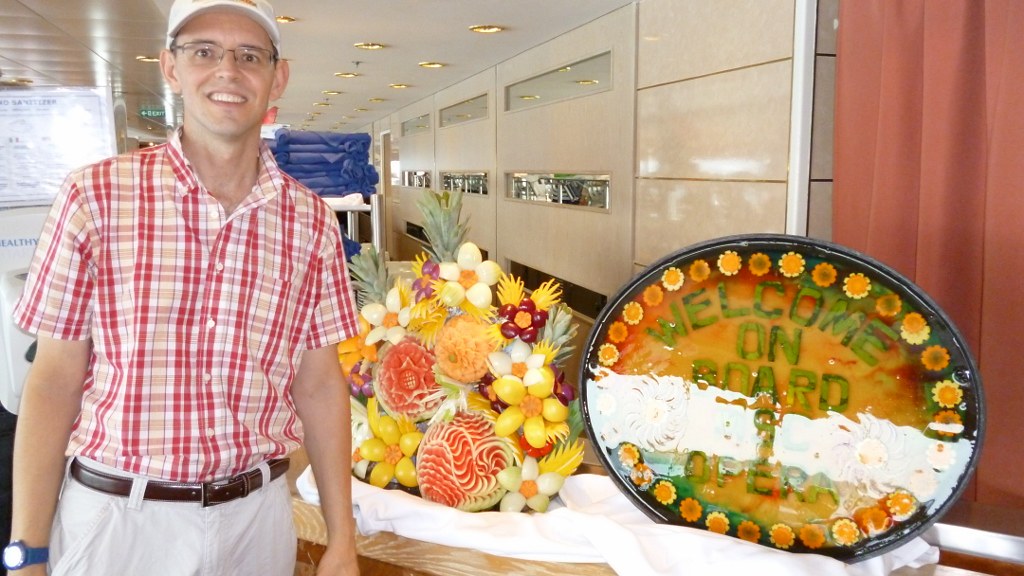
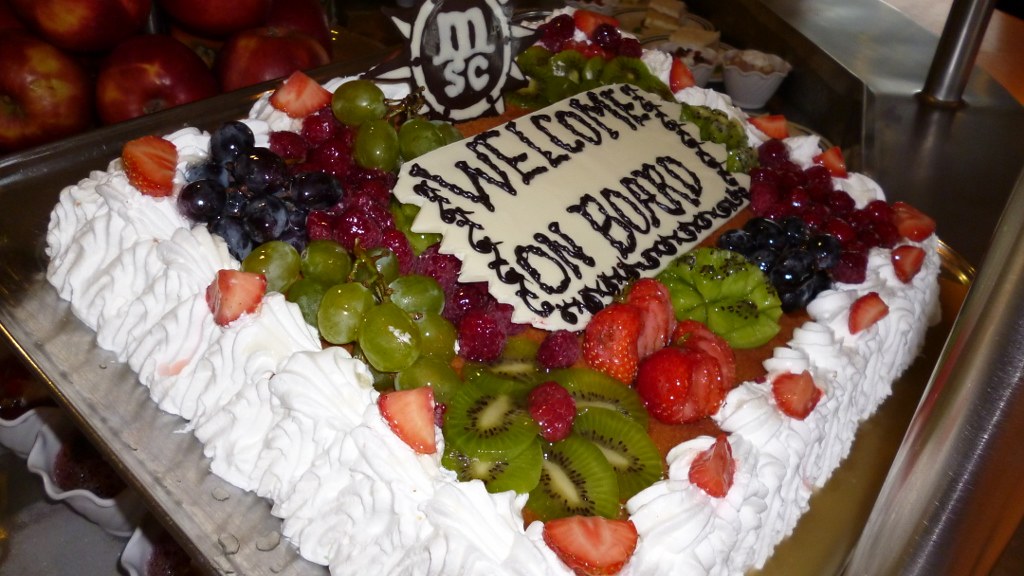 The ship had a special buffet prepared for new guests boarding in Southampton. I can’t complain about the food. Everything was delicious. The MSC Opera has two dining rooms, two dining buffets, a pizza bar, a grill and several other restaurants on board. We had early seating which meant that dinner began at 18h30 every night. We shared a table with a Russian couple from New York who loved talking about money.
The ship had a special buffet prepared for new guests boarding in Southampton. I can’t complain about the food. Everything was delicious. The MSC Opera has two dining rooms, two dining buffets, a pizza bar, a grill and several other restaurants on board. We had early seating which meant that dinner began at 18h30 every night. We shared a table with a Russian couple from New York who loved talking about money. 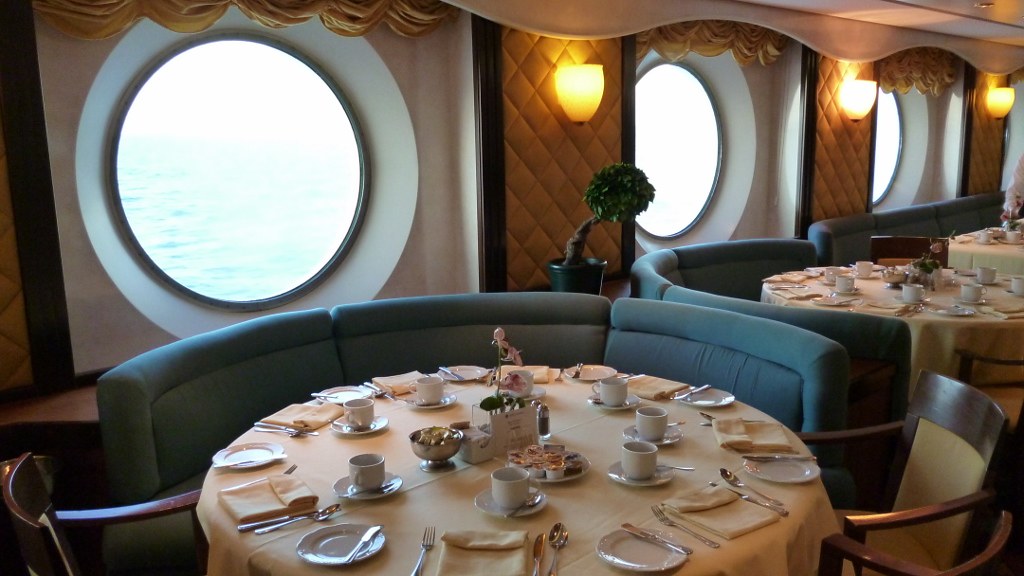 This is where we sat every night for dinner, La Carevella Restaurant. Our waiter, Alexander was from Croatia and spoke several languages. The boat was practically empty when we boarded because all of the guests were in Southampton for the day.
This is where we sat every night for dinner, La Carevella Restaurant. Our waiter, Alexander was from Croatia and spoke several languages. The boat was practically empty when we boarded because all of the guests were in Southampton for the day. 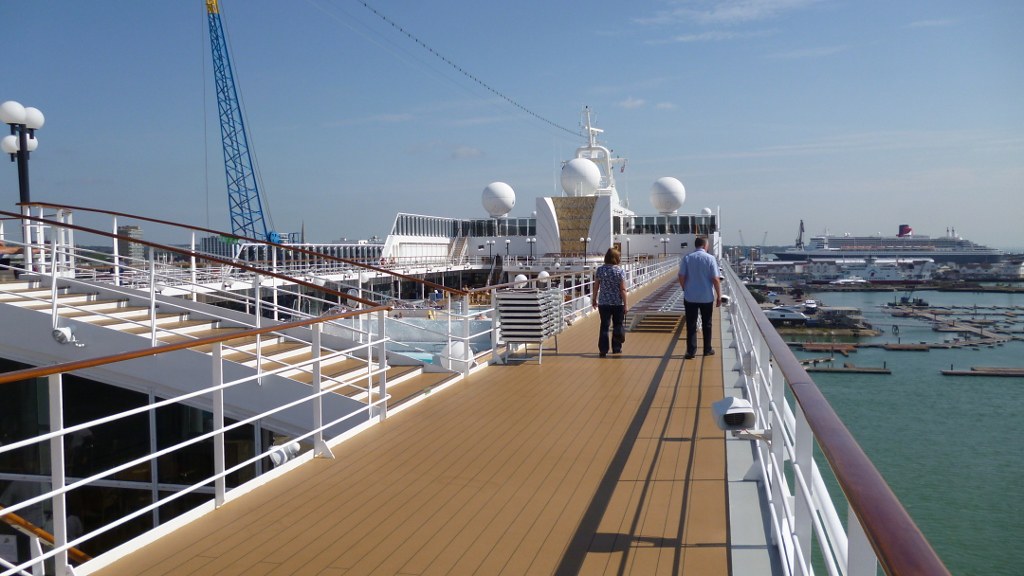
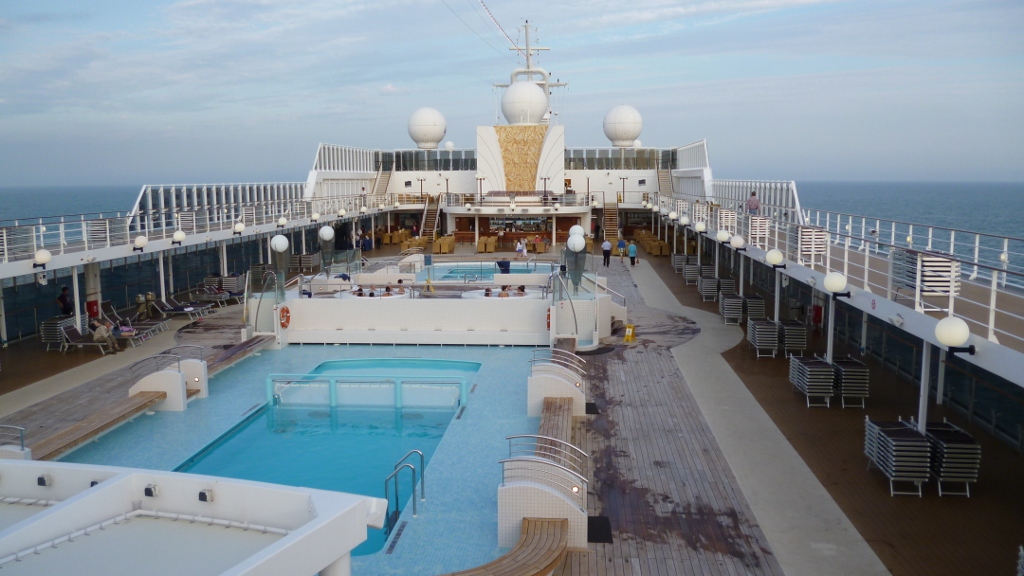 This is the view from the Soleil Deck. That’s the Queen Mary II in the background.
This is the view from the Soleil Deck. That’s the Queen Mary II in the background. 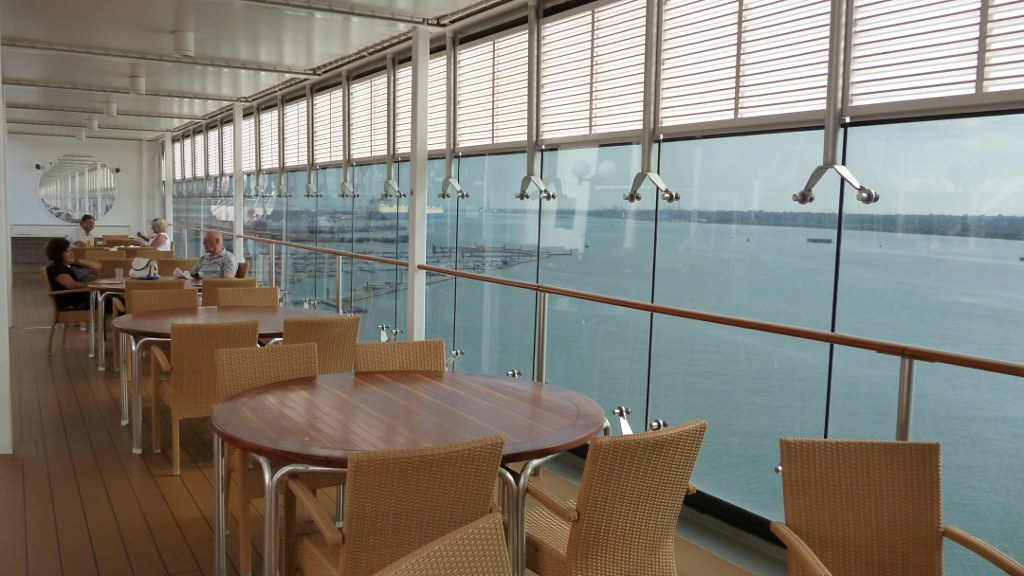 Tables on the patio deck 12, La Bohème. This was a great place to sit and have a beer after a long excursion.
Tables on the patio deck 12, La Bohème. This was a great place to sit and have a beer after a long excursion. 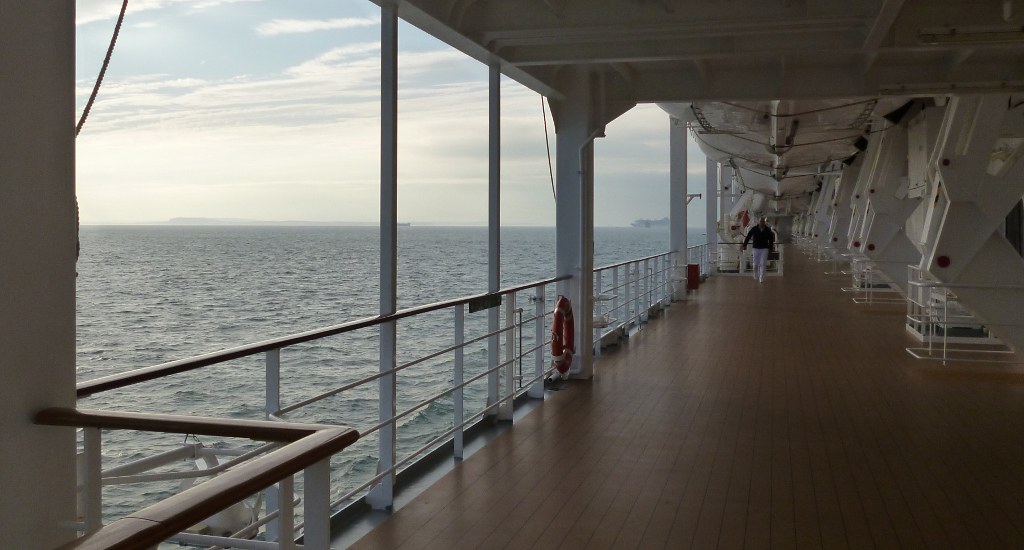
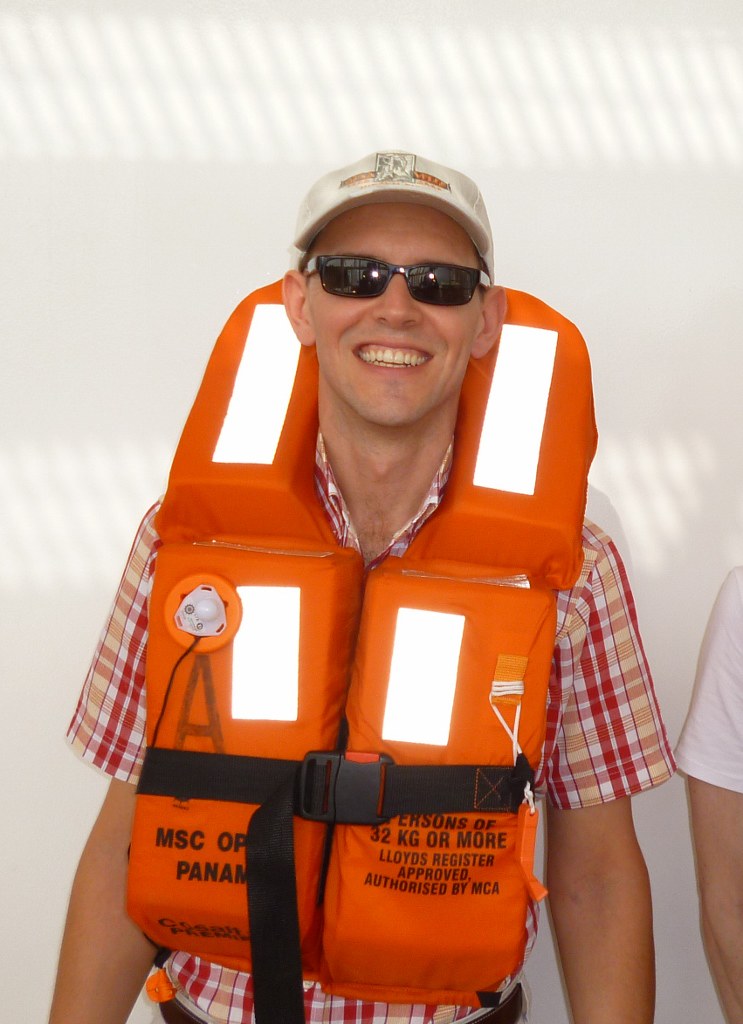 The promenade on deck 6, Otello was where we had our life jacket and muster station drill.
The promenade on deck 6, Otello was where we had our life jacket and muster station drill. 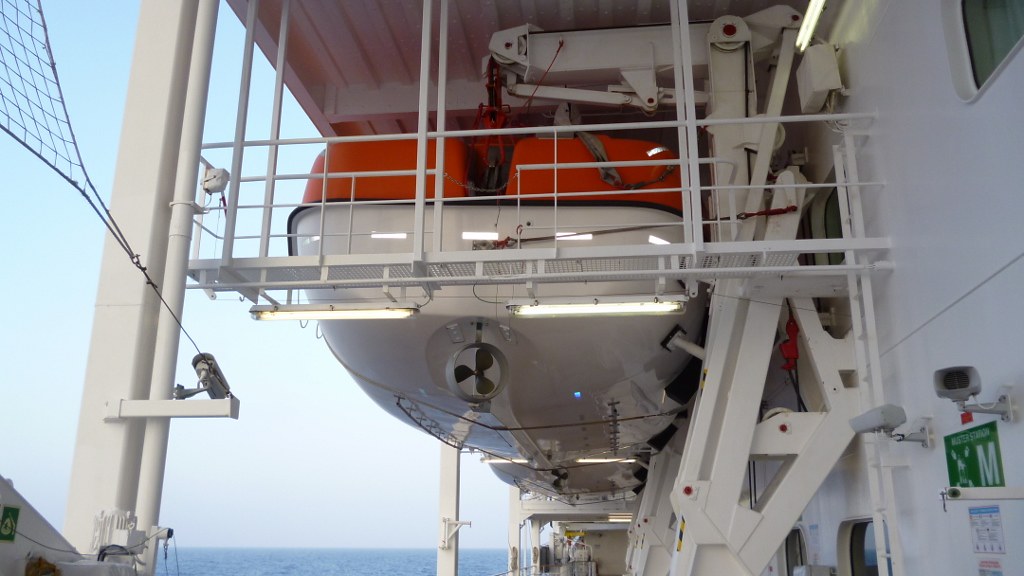 I counted 14 lifeboats. I’m pretty sure that’s enough. All of the decks were named after famous operas while some of the lounges were named after famous singers.
I counted 14 lifeboats. I’m pretty sure that’s enough. All of the decks were named after famous operas while some of the lounges were named after famous singers.  This is the Caruso Lounge where the entertainment team provided lots of after-hours activities. I was always in bed resting for the excursion the next day.
This is the Caruso Lounge where the entertainment team provided lots of after-hours activities. I was always in bed resting for the excursion the next day. 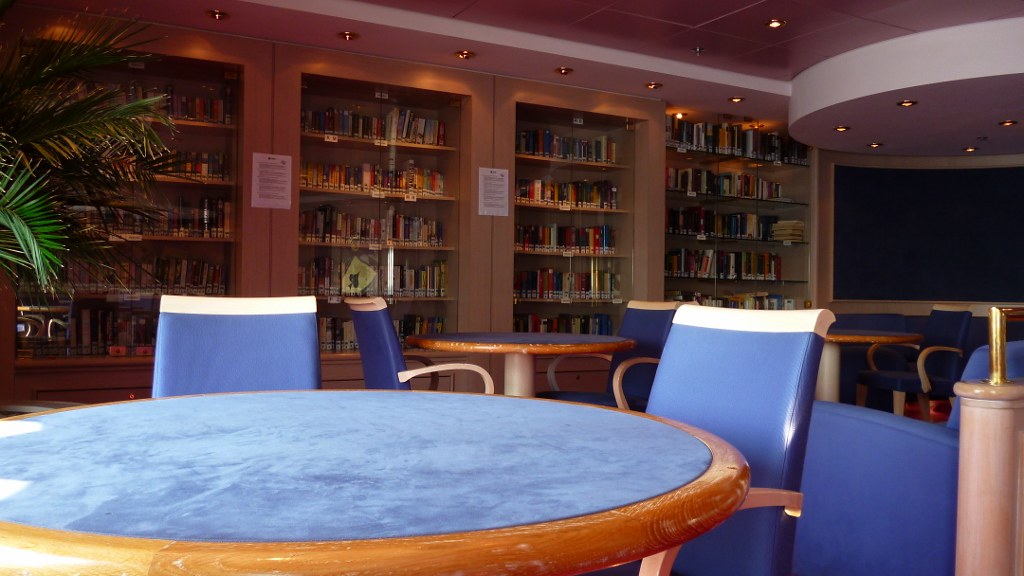 The library and gameroom.
The library and gameroom. 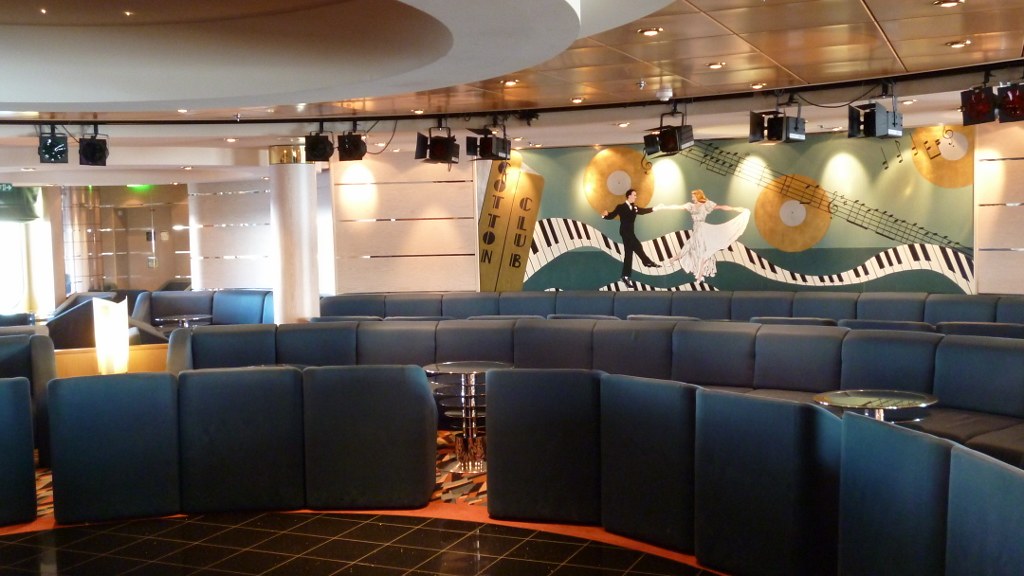
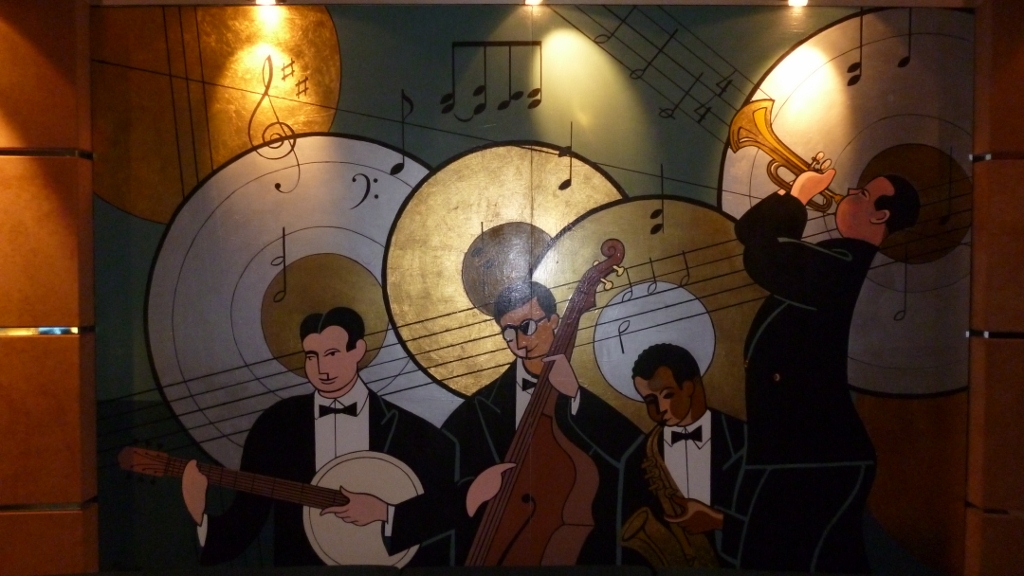 The Cotton Club had jazz music and dance every evening.
The Cotton Club had jazz music and dance every evening. 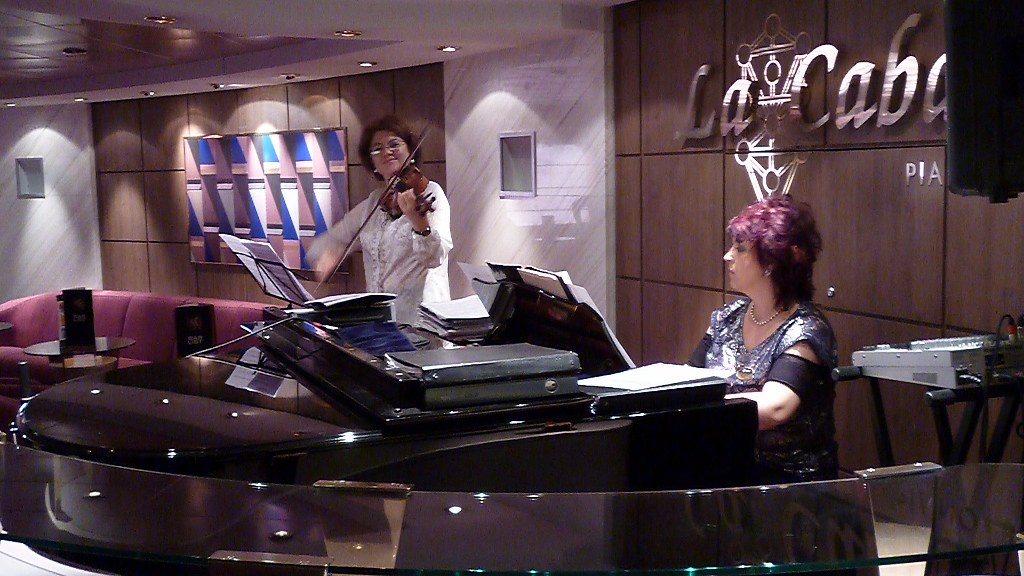
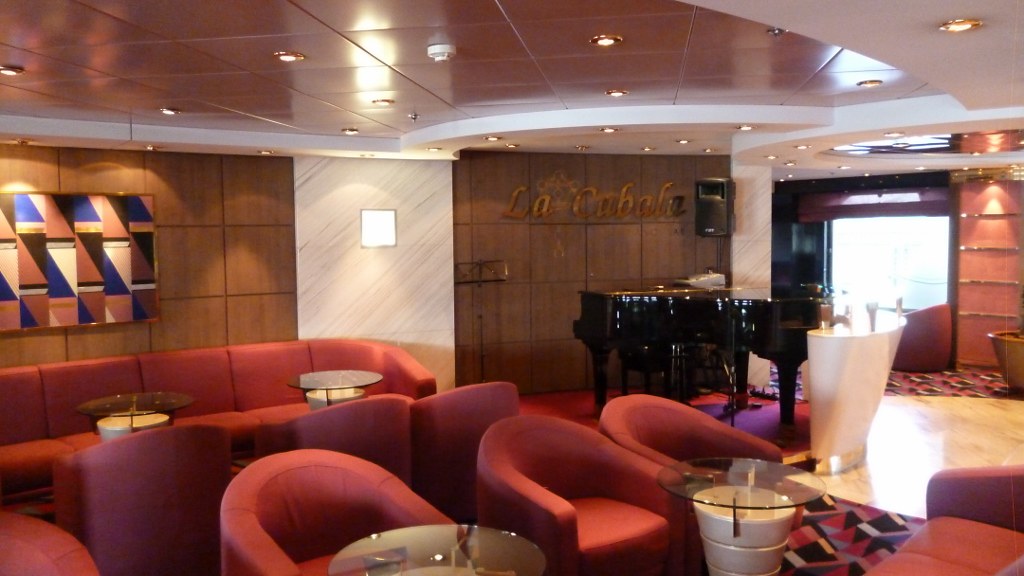 The La Cabala Lounge had piano and violin classical music every evening. The classical music theme and entertainment on board were very relaxing.
The La Cabala Lounge had piano and violin classical music every evening. The classical music theme and entertainment on board were very relaxing. 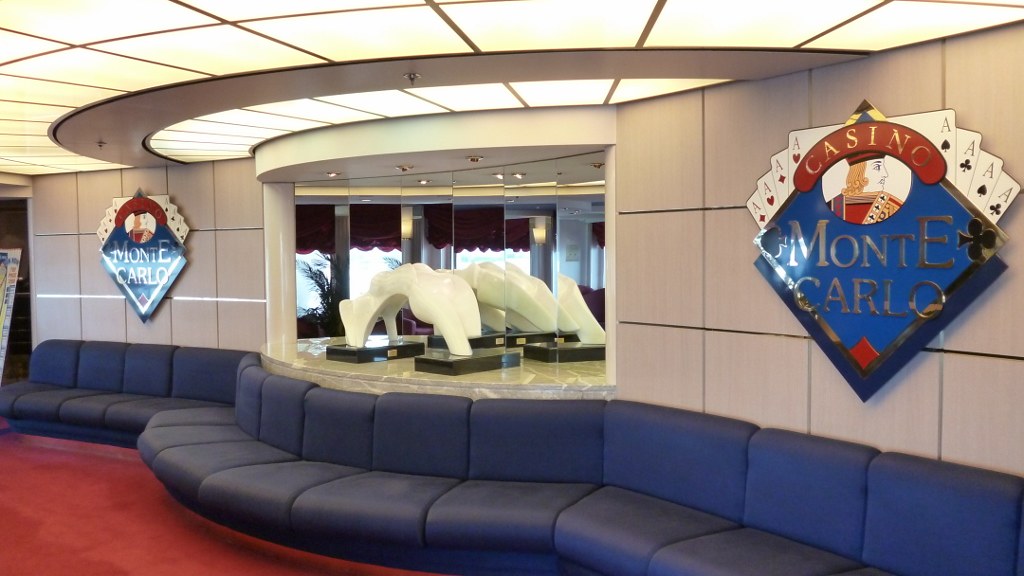
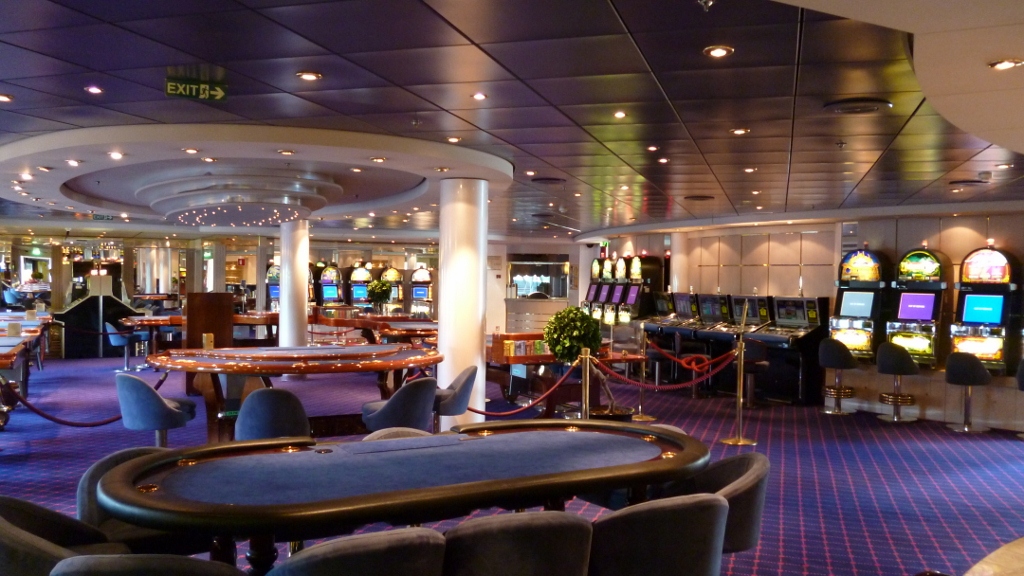
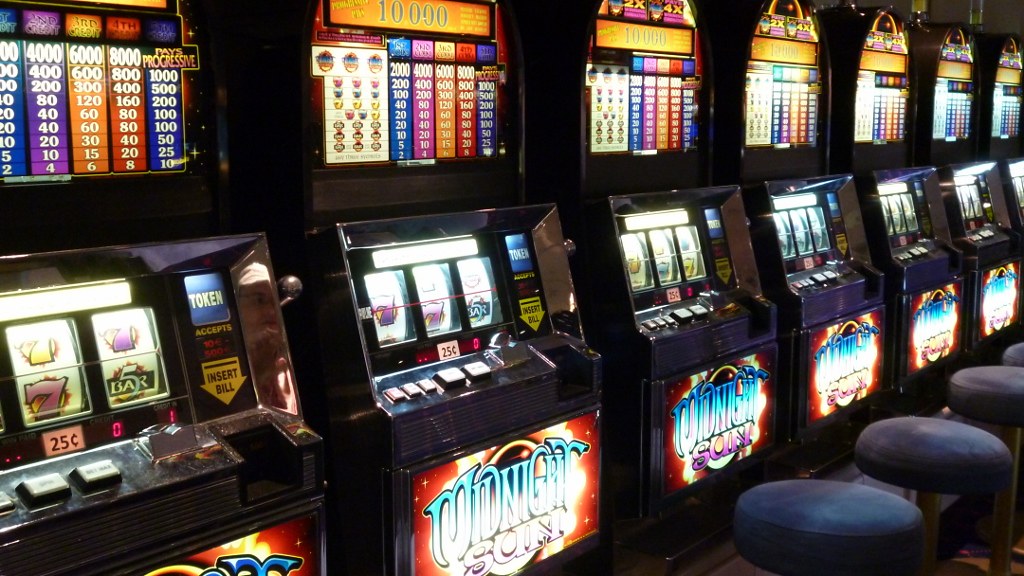 This is the Monte Carlo Casino--I don’t gamble so I didn’t go to the Casino except to pass through. They have several slot machines, card tables and roulette wheels. This was where the smokers hung out.
This is the Monte Carlo Casino--I don’t gamble so I didn’t go to the Casino except to pass through. They have several slot machines, card tables and roulette wheels. This was where the smokers hung out. 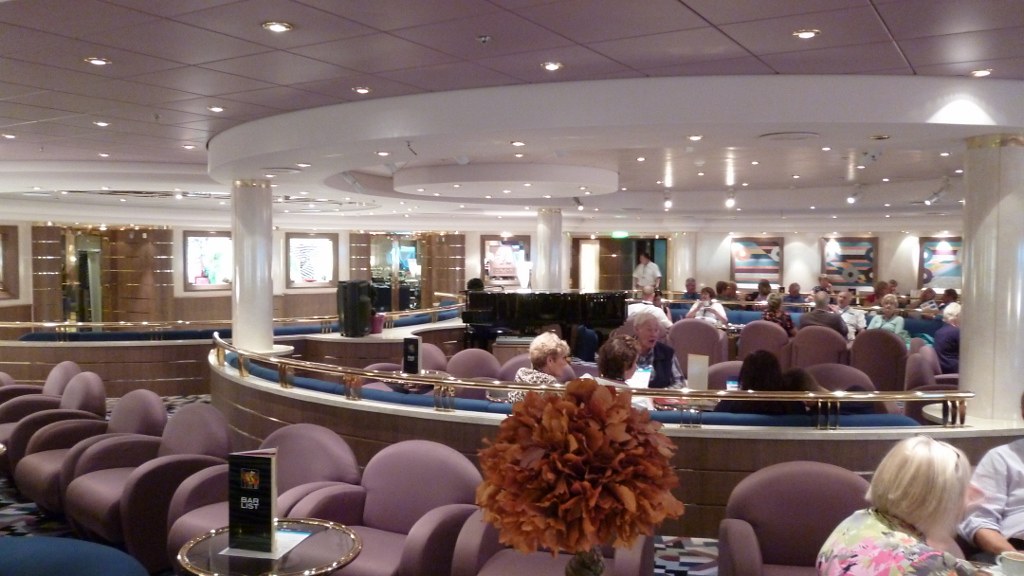 This is the Piazza di Spagna Lounge on deck 5 which had all of the specialty shops.
This is the Piazza di Spagna Lounge on deck 5 which had all of the specialty shops. 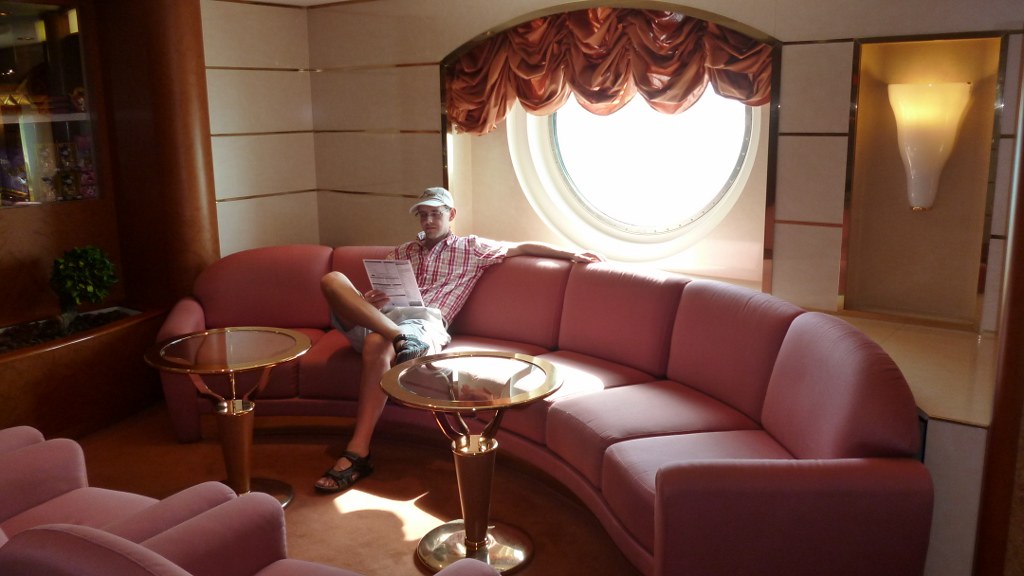 This is one of the smaller lounges near the shore excursions desk.
This is one of the smaller lounges near the shore excursions desk. 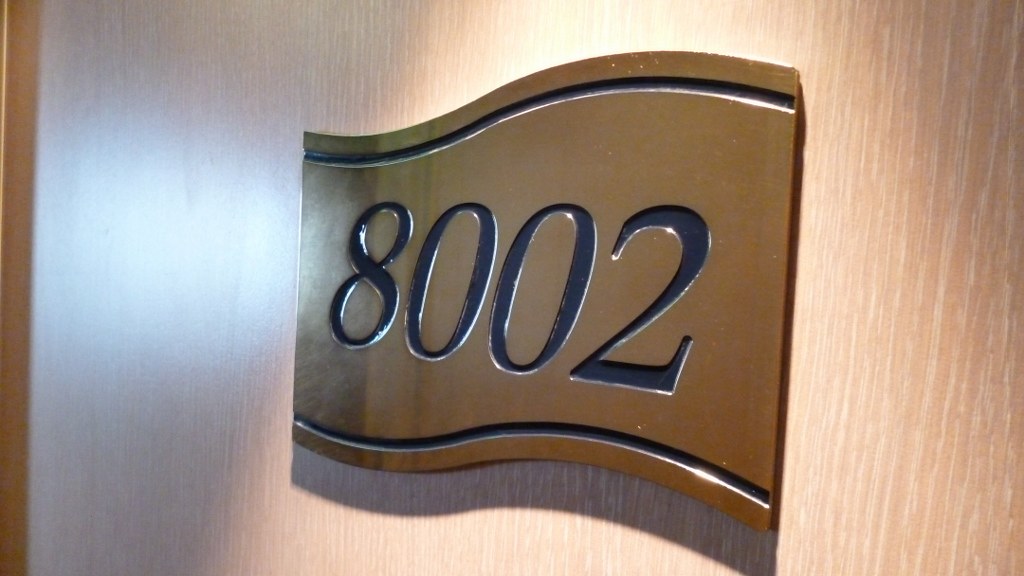


 My room was 8002 on deck 8, La Traviata at the very front of the ship. It was exceptionally quiet. Great views from the front deck every morning.
My room was 8002 on deck 8, La Traviata at the very front of the ship. It was exceptionally quiet. Great views from the front deck every morning.  This is a view of the hallway on deck 8 looking toward the back of the ship.
This is a view of the hallway on deck 8 looking toward the back of the ship. 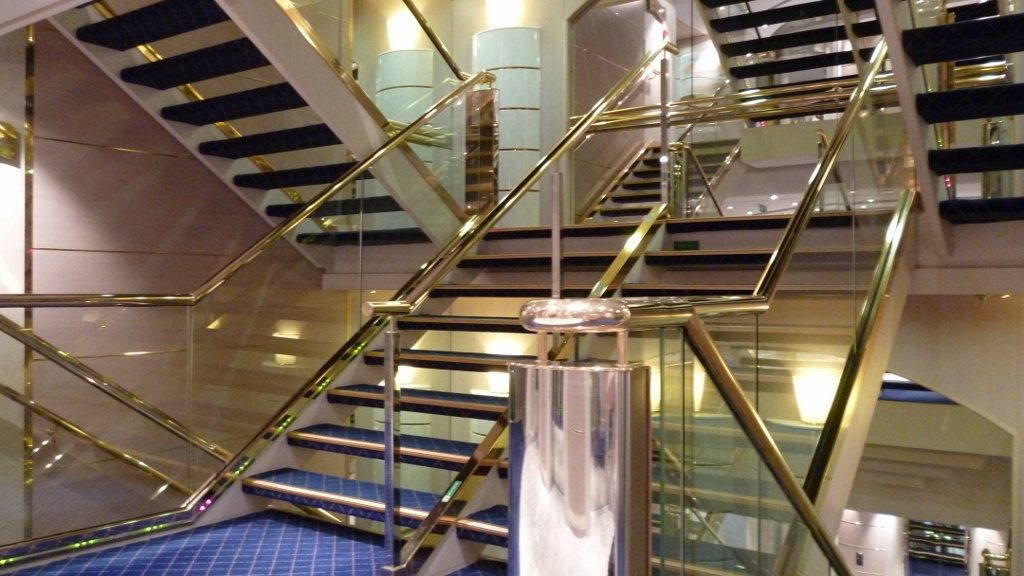 We barely ever used the elevators preferring to use the stairs for everything.
We barely ever used the elevators preferring to use the stairs for everything.  The Theatro dell’ Opera was small but very classy. Our evening entertainment took place here with live classical music concerts, opera singers, ballet dancers, vaudeville performers and lots more. I’ll post some photos of our shows later.
The Theatro dell’ Opera was small but very classy. Our evening entertainment took place here with live classical music concerts, opera singers, ballet dancers, vaudeville performers and lots more. I’ll post some photos of our shows later. 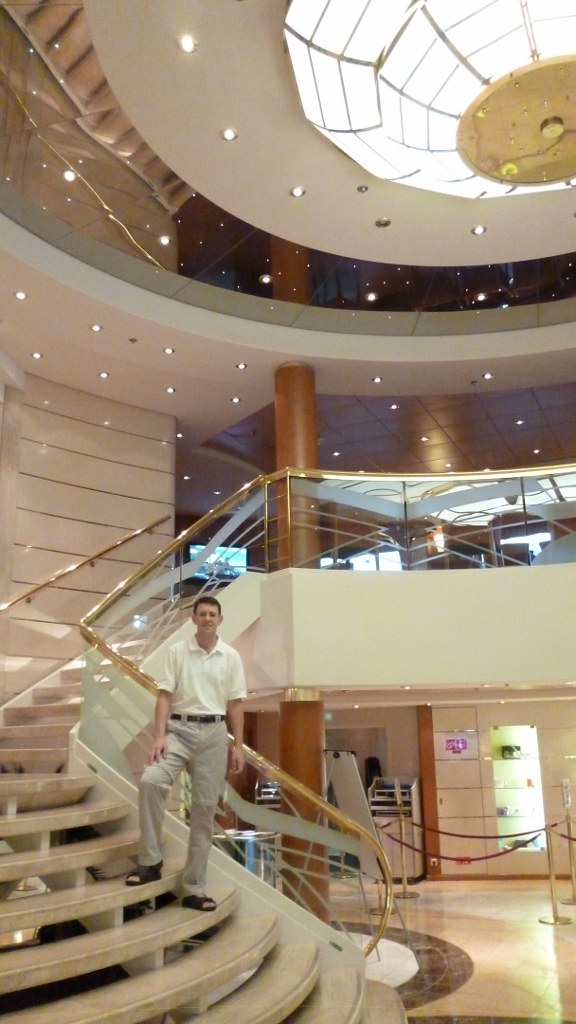 The grand staircase was a popular place to get ones photograph.
The grand staircase was a popular place to get ones photograph. 
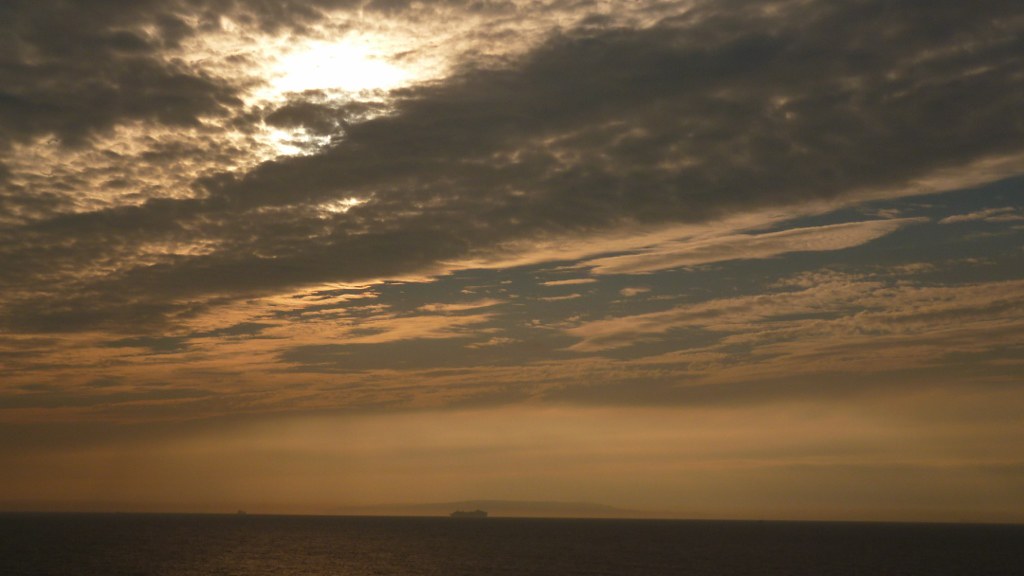
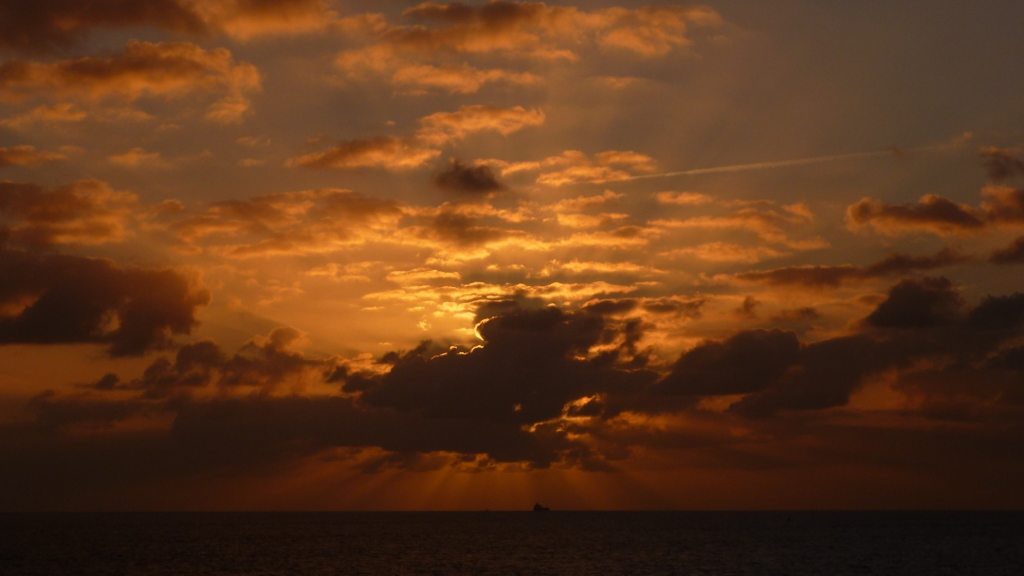
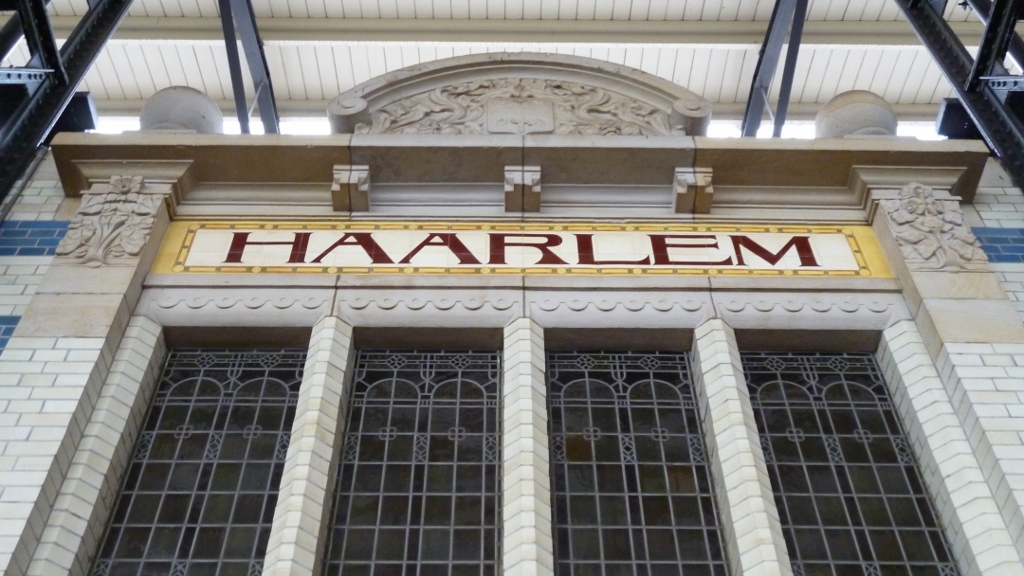 Our first stop after leaving Southampton was on 5 September at the port of Ijmuiden, Netherlands. Most people spent the day on excursions to Amsterdam. Since I’ve been to Amsterdam several times, I went to Haarlem instead. It has all of the charm of Amsterdam’s canals and wonderful buildings without all of the walking and getting lost!
Our first stop after leaving Southampton was on 5 September at the port of Ijmuiden, Netherlands. Most people spent the day on excursions to Amsterdam. Since I’ve been to Amsterdam several times, I went to Haarlem instead. It has all of the charm of Amsterdam’s canals and wonderful buildings without all of the walking and getting lost! 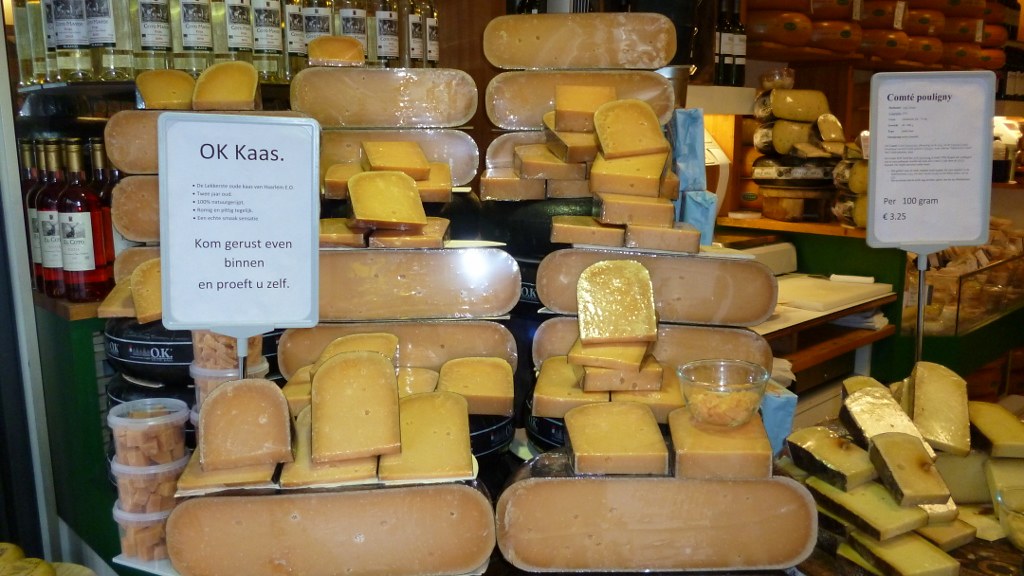 A wine and cheese store in Haarlem. I spent the entire day exploring Haarlem with a walking map. I was impressed with how spotless everything was—certainly different from Amsterdam.
A wine and cheese store in Haarlem. I spent the entire day exploring Haarlem with a walking map. I was impressed with how spotless everything was—certainly different from Amsterdam. 
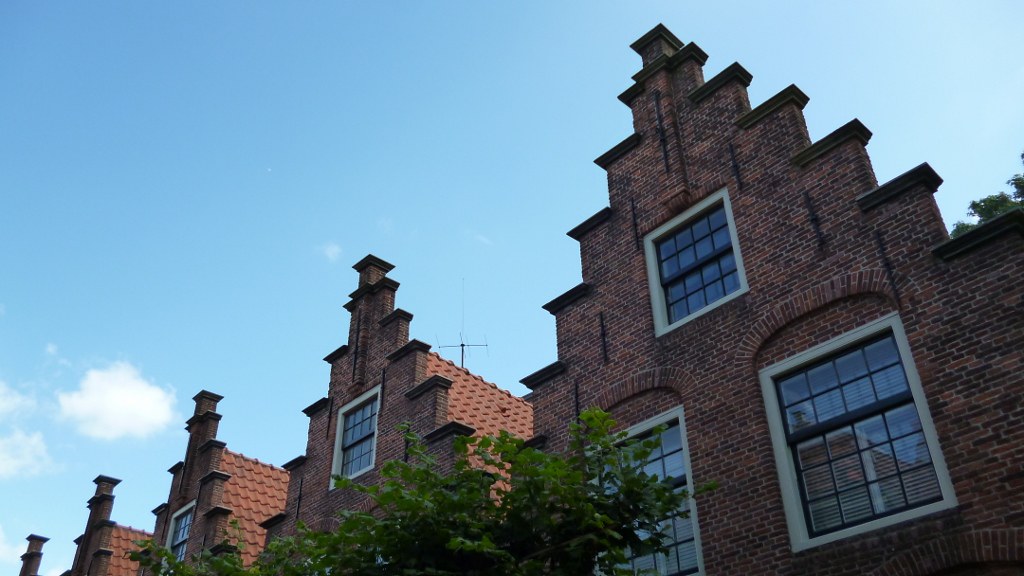 These are some of the traditional houses along the river Spaarne.
These are some of the traditional houses along the river Spaarne.  The white drawbridge is called Gravestenenbrug. The two monumental buildings in the background have stepped gables, dating from around 1630. From 1550 the buildings behind these gables housed the brewery De Olyphant. For centuries, Haarlem was one of the largest beer brewing cities in the Netherlands. A famous Haarlem beer called Jopenbier was reintroduced in 1994 and is brewed according to an authentic recipe found in the municipal archives.
The white drawbridge is called Gravestenenbrug. The two monumental buildings in the background have stepped gables, dating from around 1630. From 1550 the buildings behind these gables housed the brewery De Olyphant. For centuries, Haarlem was one of the largest beer brewing cities in the Netherlands. A famous Haarlem beer called Jopenbier was reintroduced in 1994 and is brewed according to an authentic recipe found in the municipal archives.  We sat outside in the Grote Markt and had a glass.
We sat outside in the Grote Markt and had a glass. 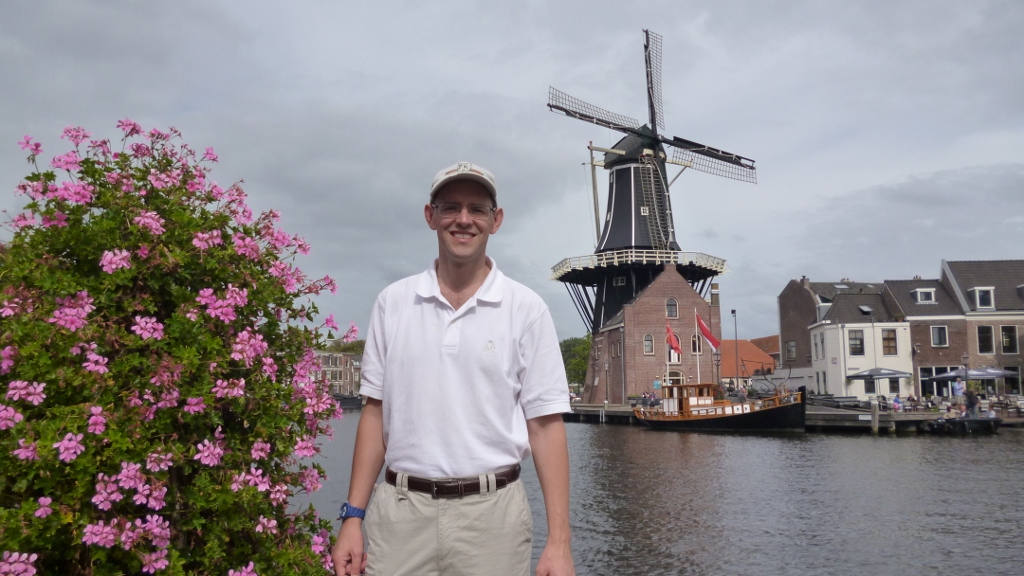 De Adriaan is a windmill in Haarlem that burnt down in 1932 and was rebuilt in 2002. The original windmill dates from 1779 and the mill has been a distinctive part of the skyline of Haarlem for centuries.
De Adriaan is a windmill in Haarlem that burnt down in 1932 and was rebuilt in 2002. The original windmill dates from 1779 and the mill has been a distinctive part of the skyline of Haarlem for centuries. 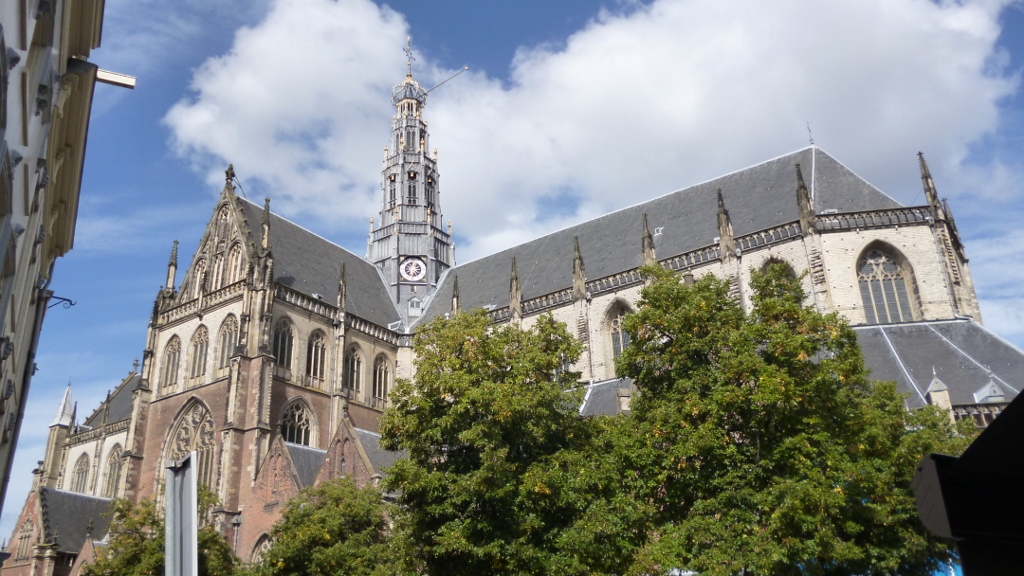 The Grote Kerk or St. Bavokerk is a Protestant church and former Catholic cathedral located on the central market square. This church is an important landmark for the city of Haarlem and has dominated the city skyline for centuries. It is built in the Gothic style of architecture, and it became the main church of Haarlem after renovations in the 15th century made it significantly larger than the Janskerk. First mention of a church on this spot was made in 1307, but the wooden structure burned in the 14th century. The church was rebuilt and promoted to chapter church in 1479 and only became a cathedral in 1559. The St. Bavokerk is sometimes called ‘Jan met de hoge schouders’ (Jan with the tall shoulders), as the steeple is rather small in proportion to the rest of the building.
The Grote Kerk or St. Bavokerk is a Protestant church and former Catholic cathedral located on the central market square. This church is an important landmark for the city of Haarlem and has dominated the city skyline for centuries. It is built in the Gothic style of architecture, and it became the main church of Haarlem after renovations in the 15th century made it significantly larger than the Janskerk. First mention of a church on this spot was made in 1307, but the wooden structure burned in the 14th century. The church was rebuilt and promoted to chapter church in 1479 and only became a cathedral in 1559. The St. Bavokerk is sometimes called ‘Jan met de hoge schouders’ (Jan with the tall shoulders), as the steeple is rather small in proportion to the rest of the building. 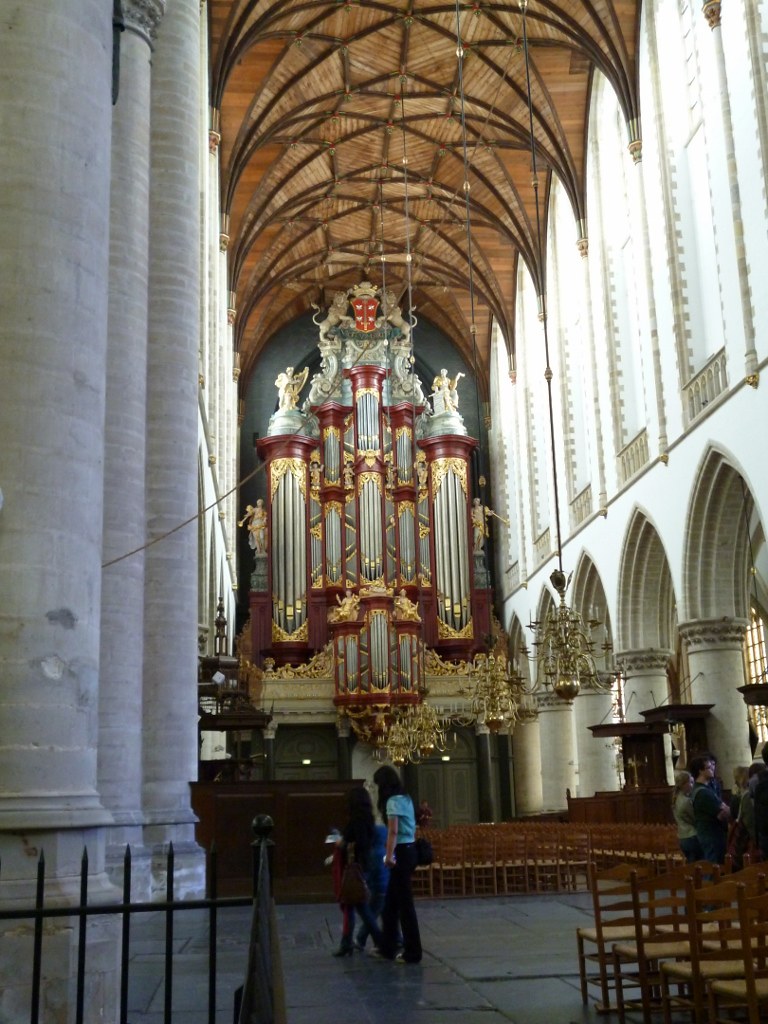 The tombstones of Frans Hals and Pieter Teyler can be found in the church, which also contains the famous Müller organ, the largest organ in the world when it was constructed between 1735 and 1738. In Moby-Dick (1851), Herman Melville describes the inside of a whale's mouth: "Seeing all these colonnades of bone so methodically ranged about, would you not think you were inside of the great Haarlem organ, and gazing upon its thousand pipes?"
The tombstones of Frans Hals and Pieter Teyler can be found in the church, which also contains the famous Müller organ, the largest organ in the world when it was constructed between 1735 and 1738. In Moby-Dick (1851), Herman Melville describes the inside of a whale's mouth: "Seeing all these colonnades of bone so methodically ranged about, would you not think you were inside of the great Haarlem organ, and gazing upon its thousand pipes?" 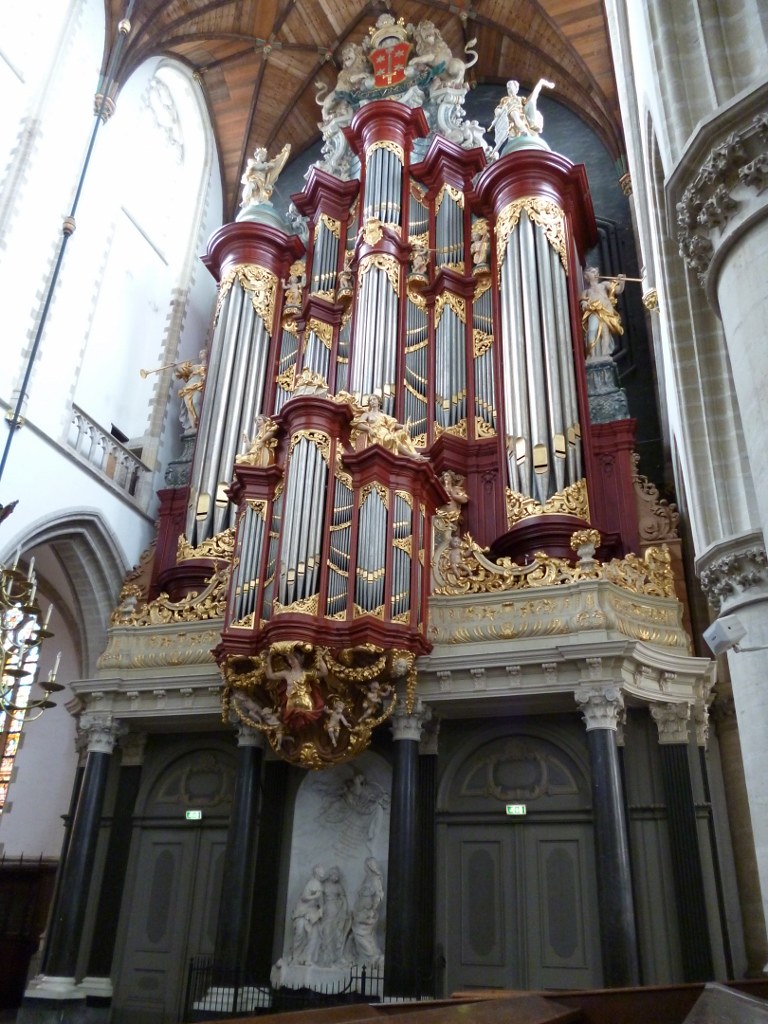 Many famous people used this organ, including Mendelssohn, Händel and the 10-year old Mozart who played it in 1766.
Many famous people used this organ, including Mendelssohn, Händel and the 10-year old Mozart who played it in 1766. 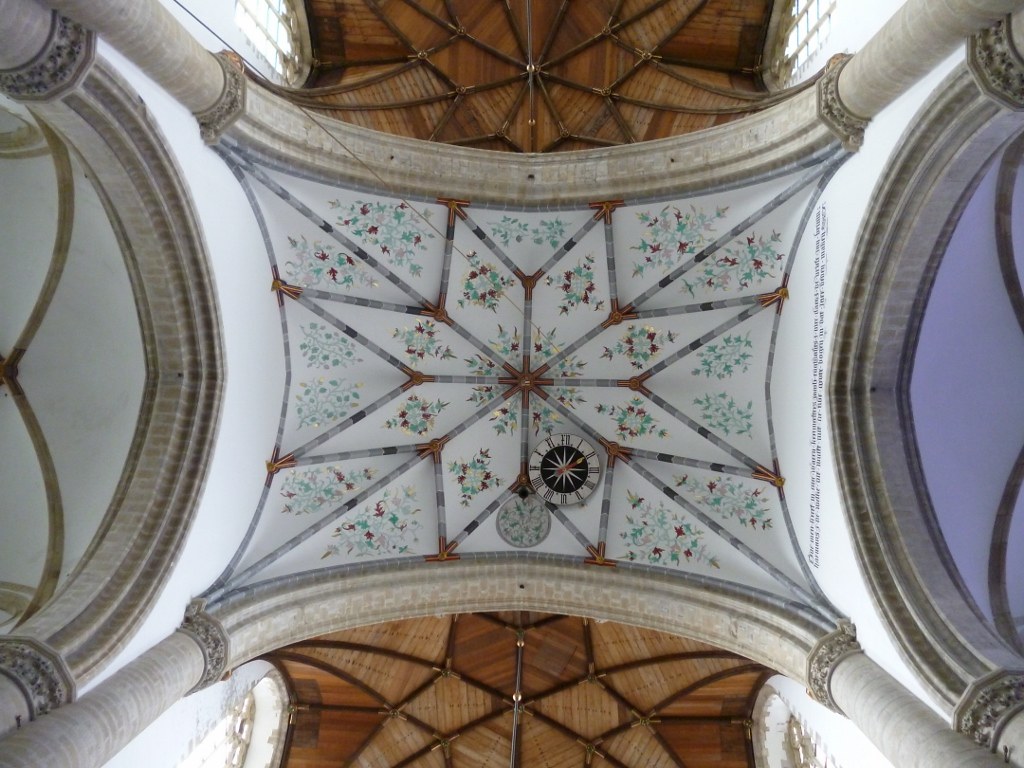 Painted arches in the transept underneath the clock tower.
Painted arches in the transept underneath the clock tower. 
 The Bakenesserkerk is a former church founded in the 13th century by William II of Holland as "Onze Lieve Vrouwenkapel". The white sandstone tower was added in 1520.
The Bakenesserkerk is a former church founded in the 13th century by William II of Holland as "Onze Lieve Vrouwenkapel". The white sandstone tower was added in 1520.  After a lot of searching, I finally found a pair of wooden shoes that fit me!
After a lot of searching, I finally found a pair of wooden shoes that fit me!  Just a few buildings in the town center called the Grote Markt.
Just a few buildings in the town center called the Grote Markt.  This is the Vleeshal (Meat Hall) and can be recognised by the stepped gable and the striking ornamentation. The city needed a meat hall, as the mushrooming population led to a growing demand for meat. In the seventeenth century, the city council commissioned city architect Lieven de Key to design a finely decorated building using the best materials. He used natural stone, which had to be imported from abroad, and adorned the building with the heads of sheep and oxen, reflecting the original function of the building.
This is the Vleeshal (Meat Hall) and can be recognised by the stepped gable and the striking ornamentation. The city needed a meat hall, as the mushrooming population led to a growing demand for meat. In the seventeenth century, the city council commissioned city architect Lieven de Key to design a finely decorated building using the best materials. He used natural stone, which had to be imported from abroad, and adorned the building with the heads of sheep and oxen, reflecting the original function of the building. 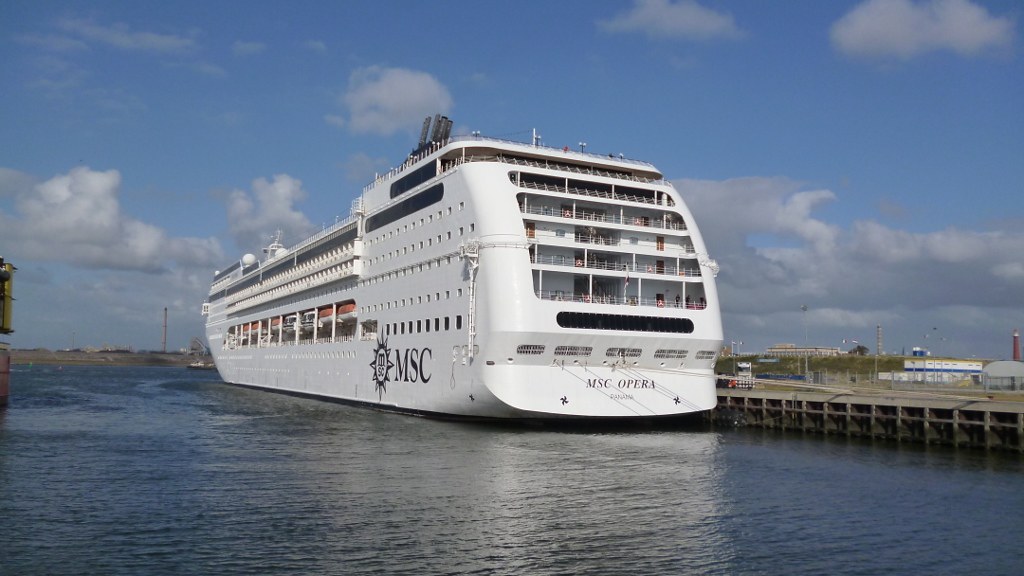 The weather was warm and sunny for our entire cruise. After seeing several other places in Haarlem we returned to the ship just in time for dinner in the La Carevella Restaurant.
The weather was warm and sunny for our entire cruise. After seeing several other places in Haarlem we returned to the ship just in time for dinner in the La Carevella Restaurant. 
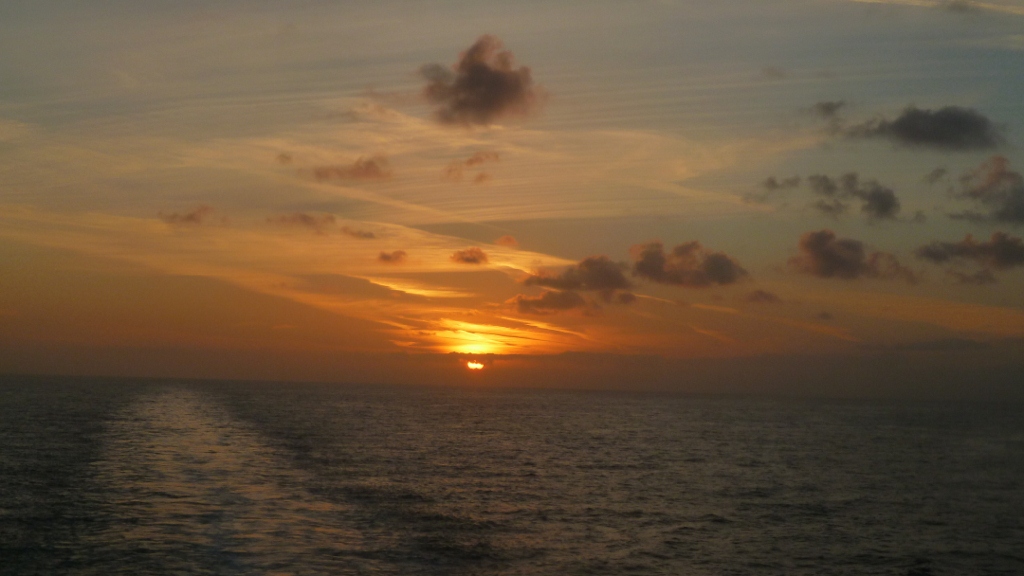 Each and every day we had spectacular sunrises and sunsets. This is the sunset on the night we left Ijmuiden on our way to our next port of call, Cherbourg.
Each and every day we had spectacular sunrises and sunsets. This is the sunset on the night we left Ijmuiden on our way to our next port of call, Cherbourg.


